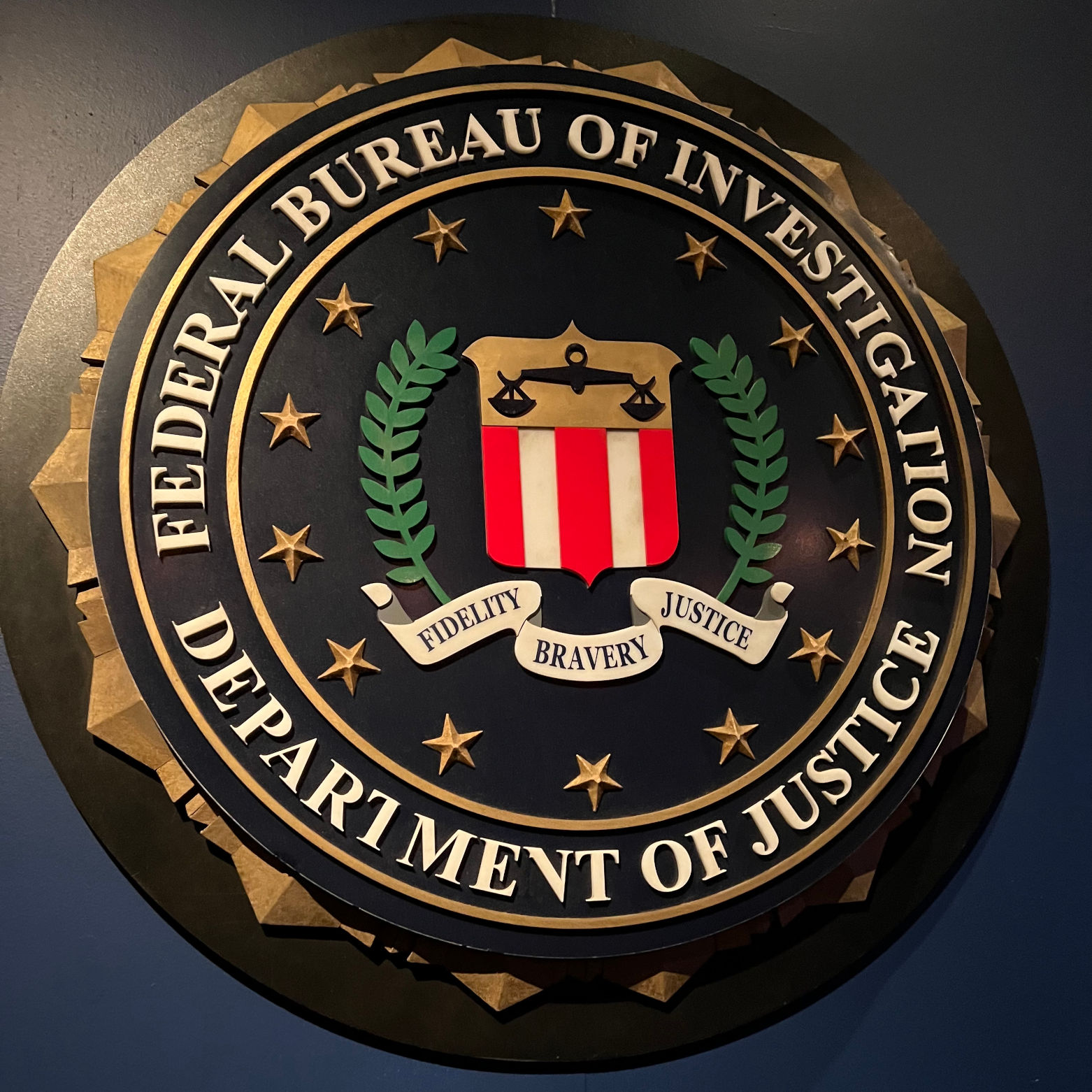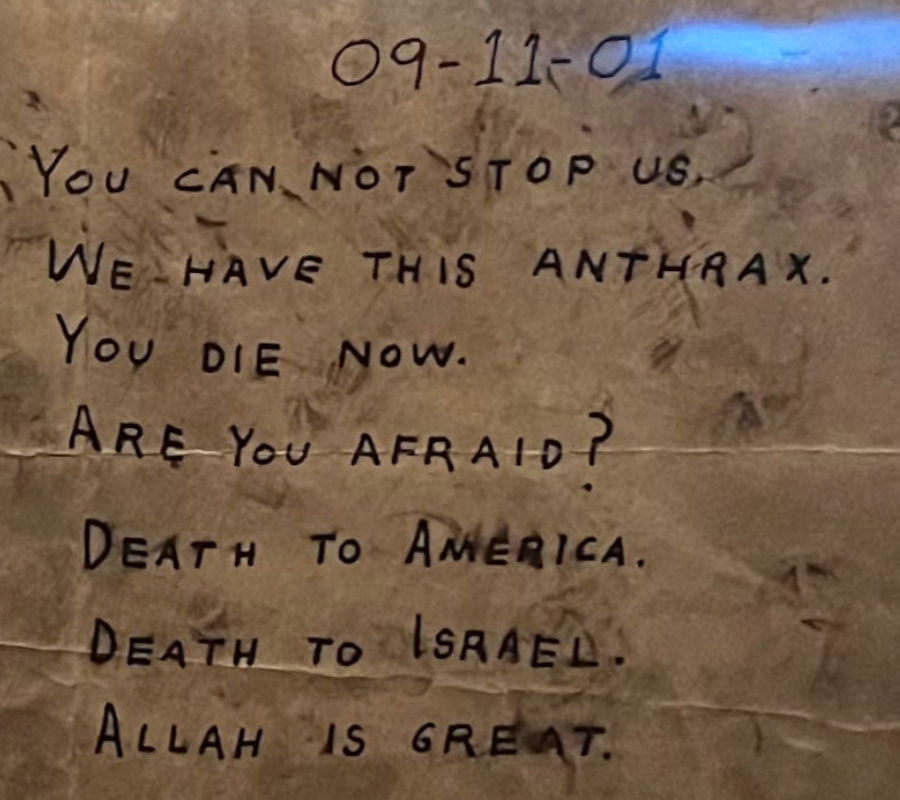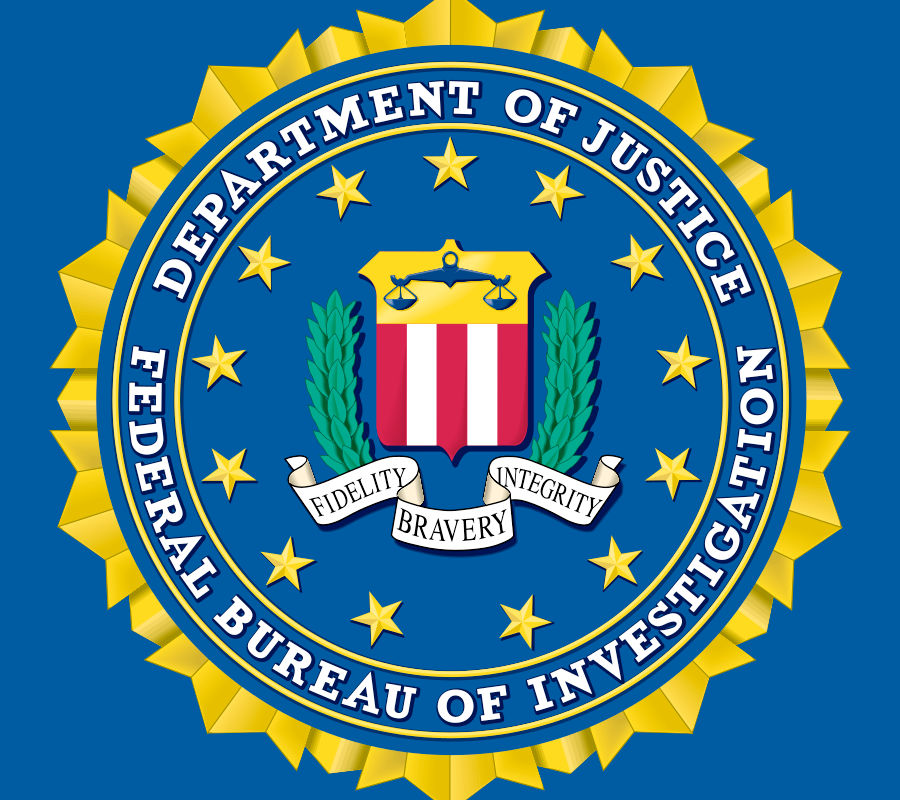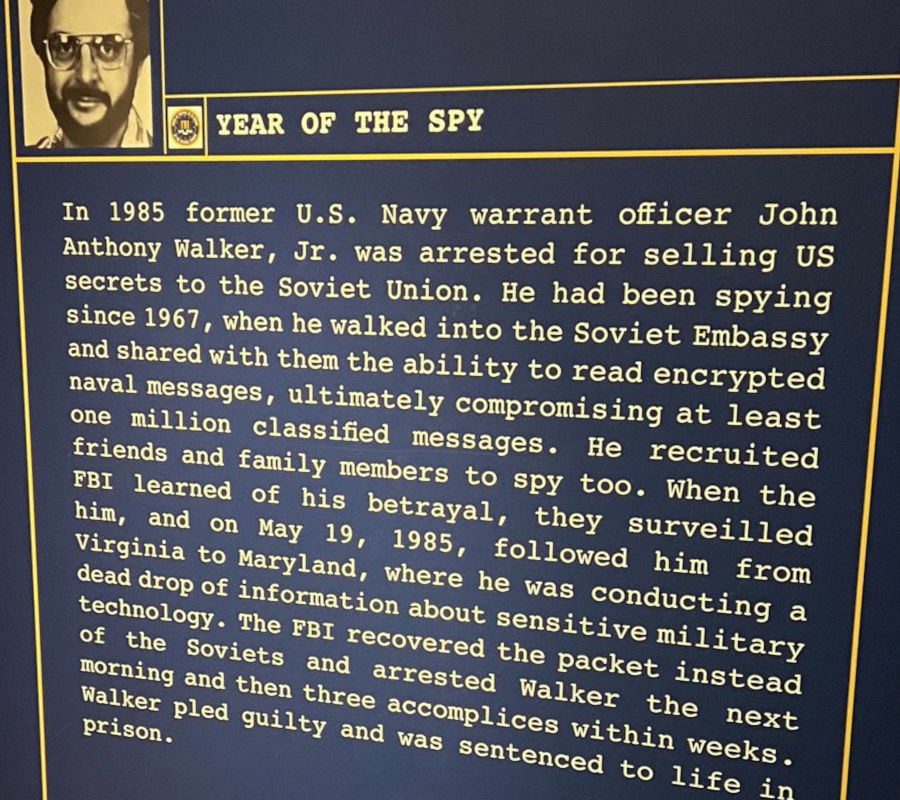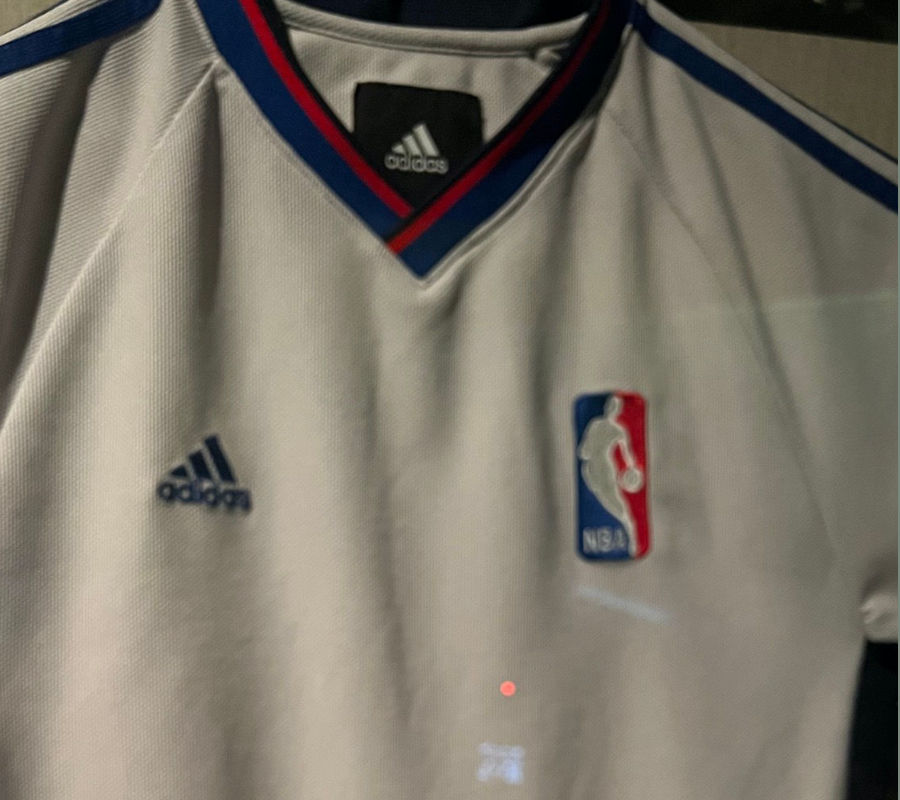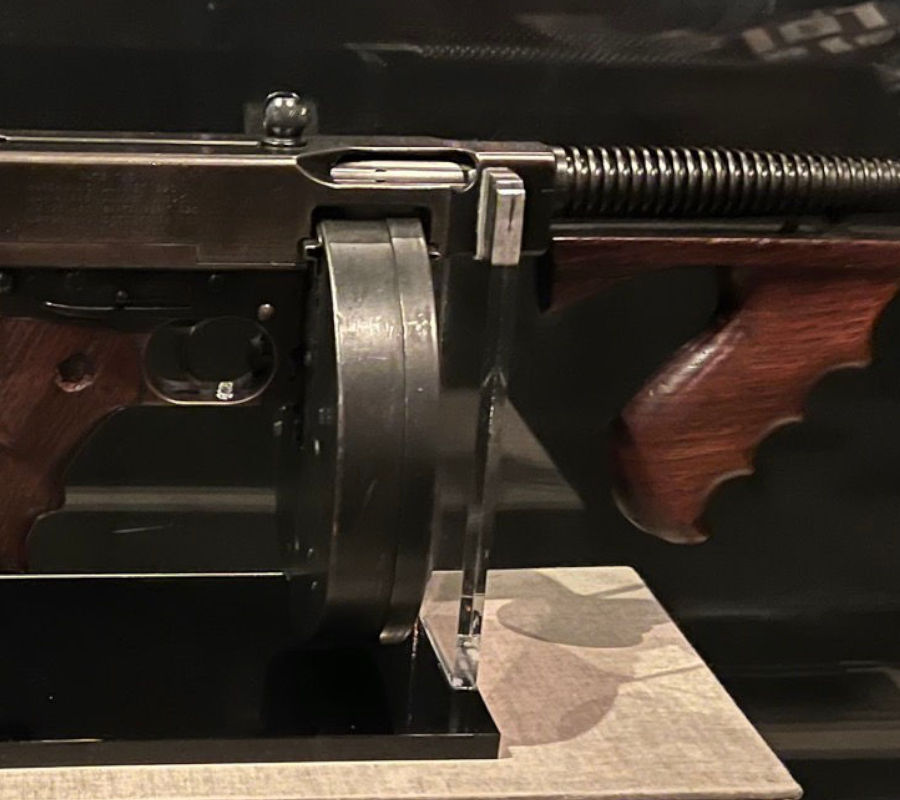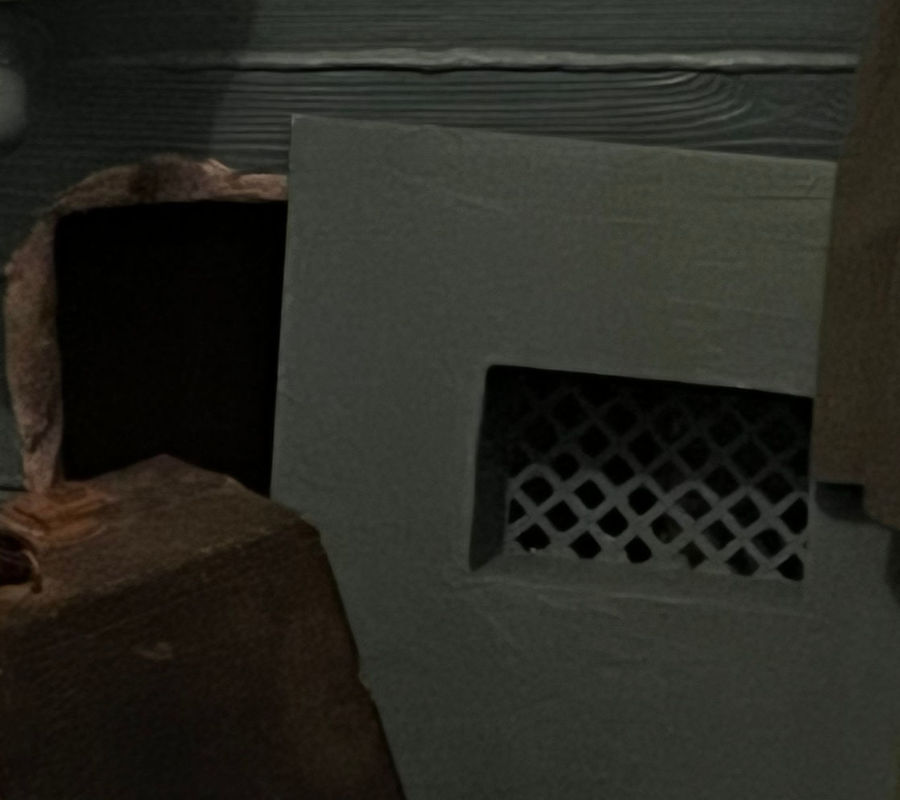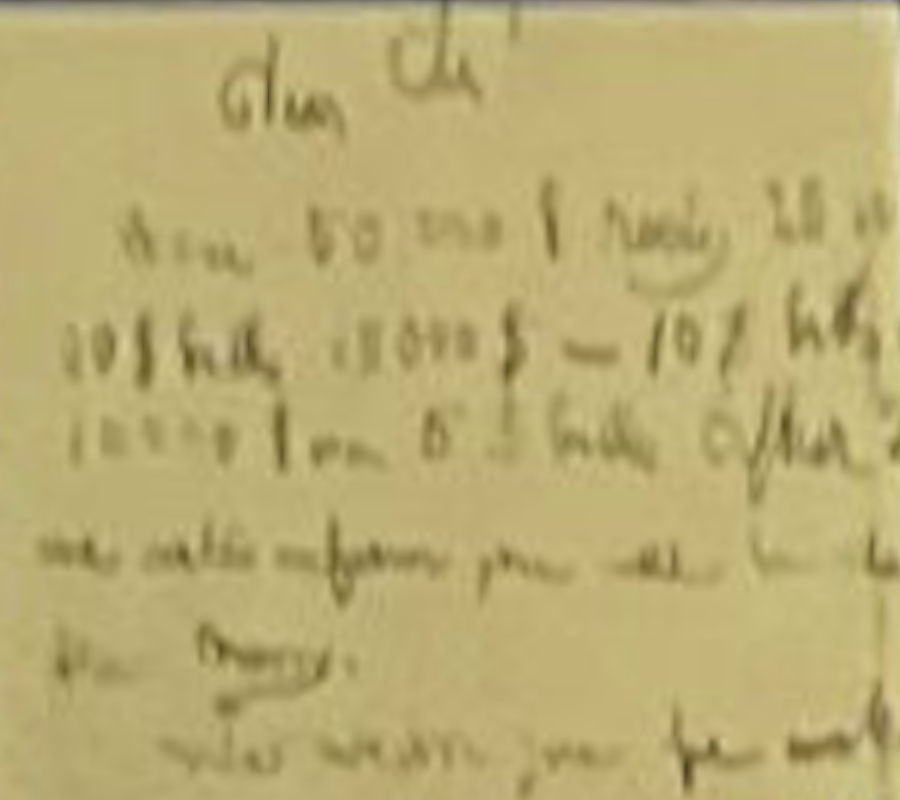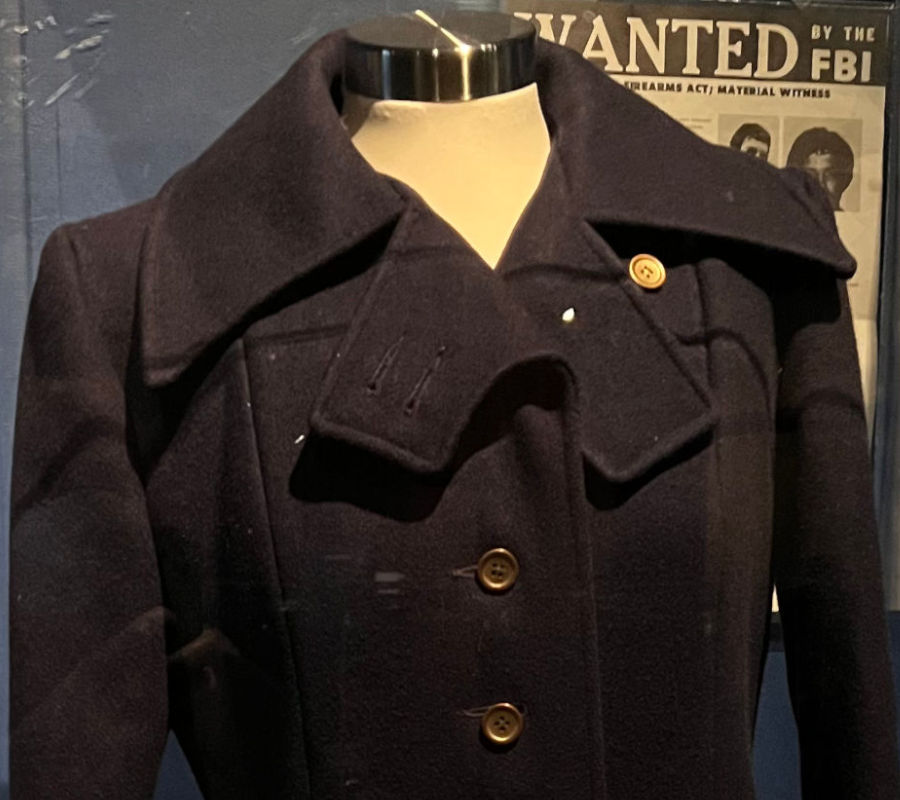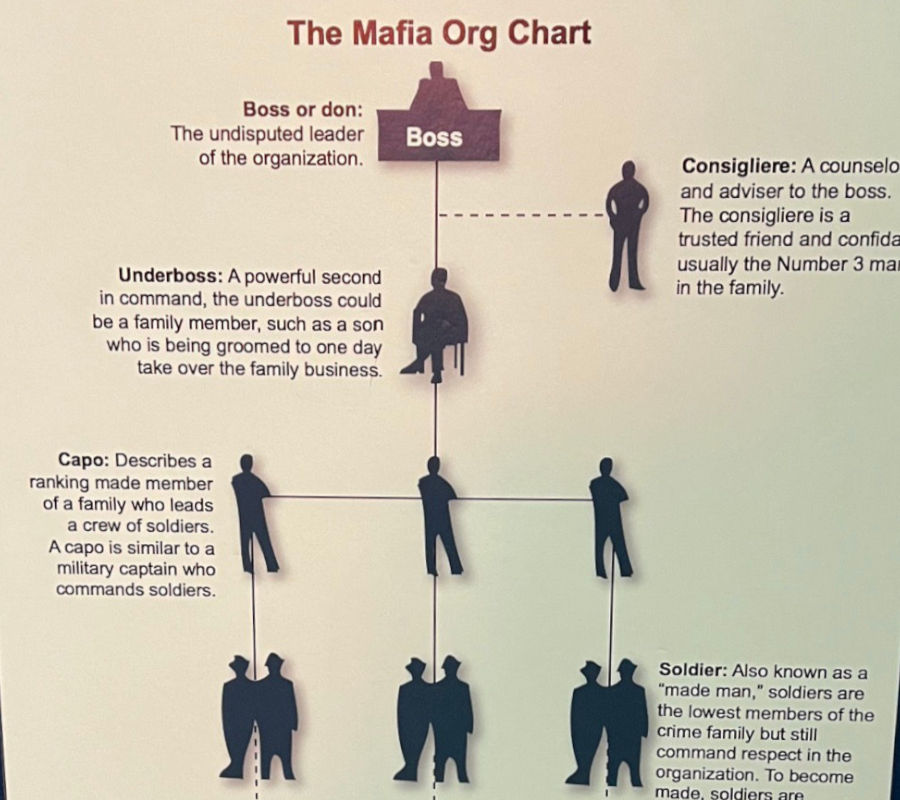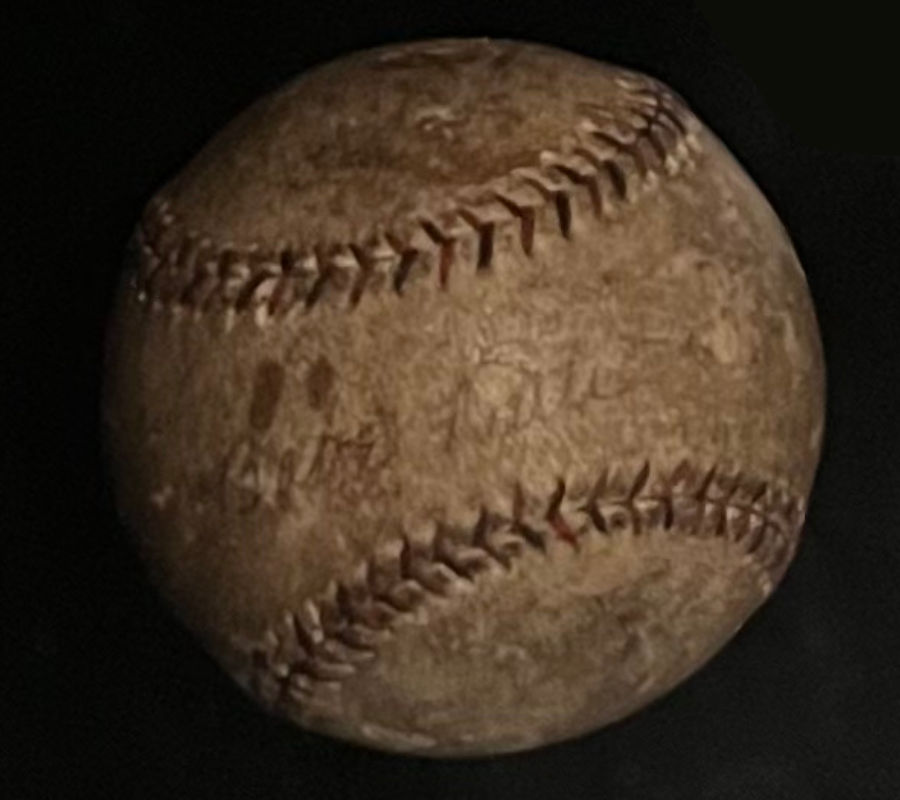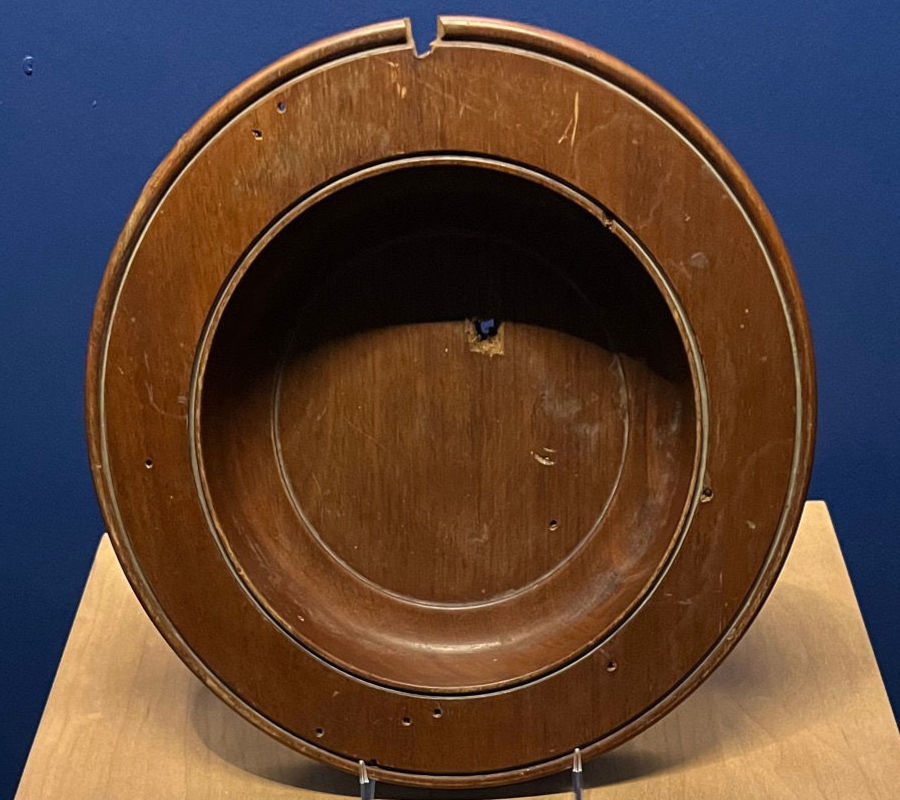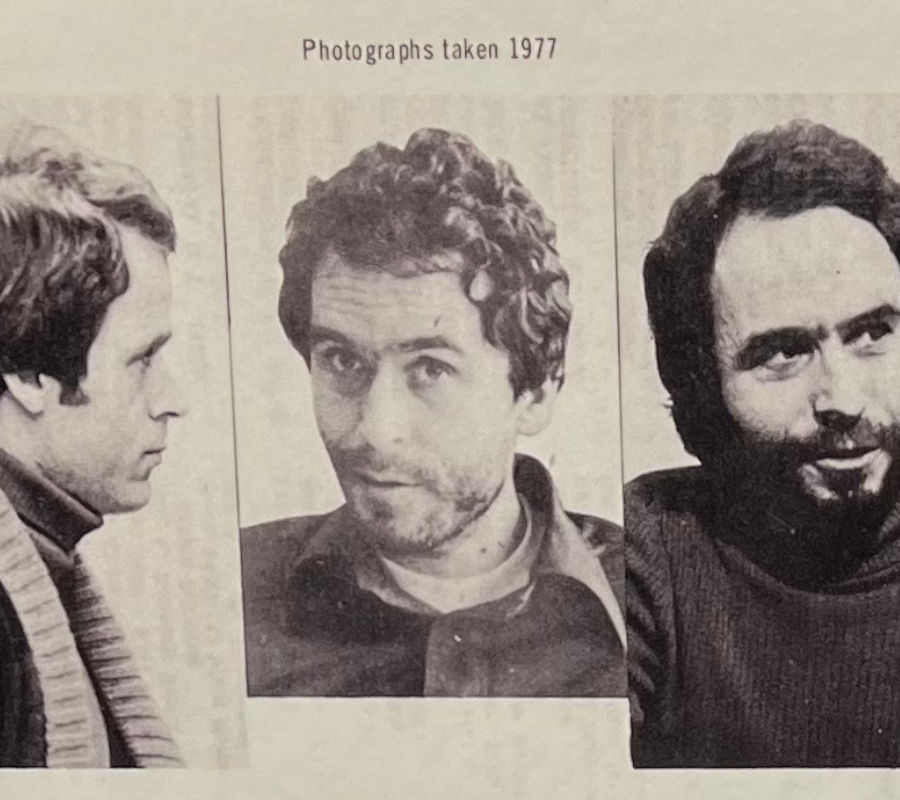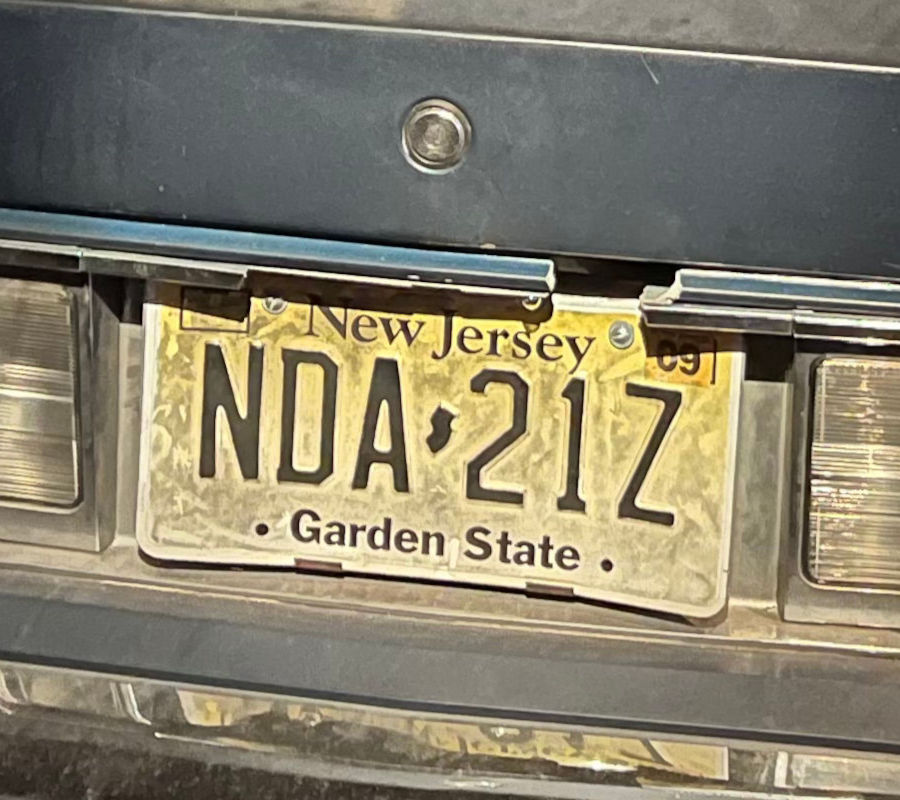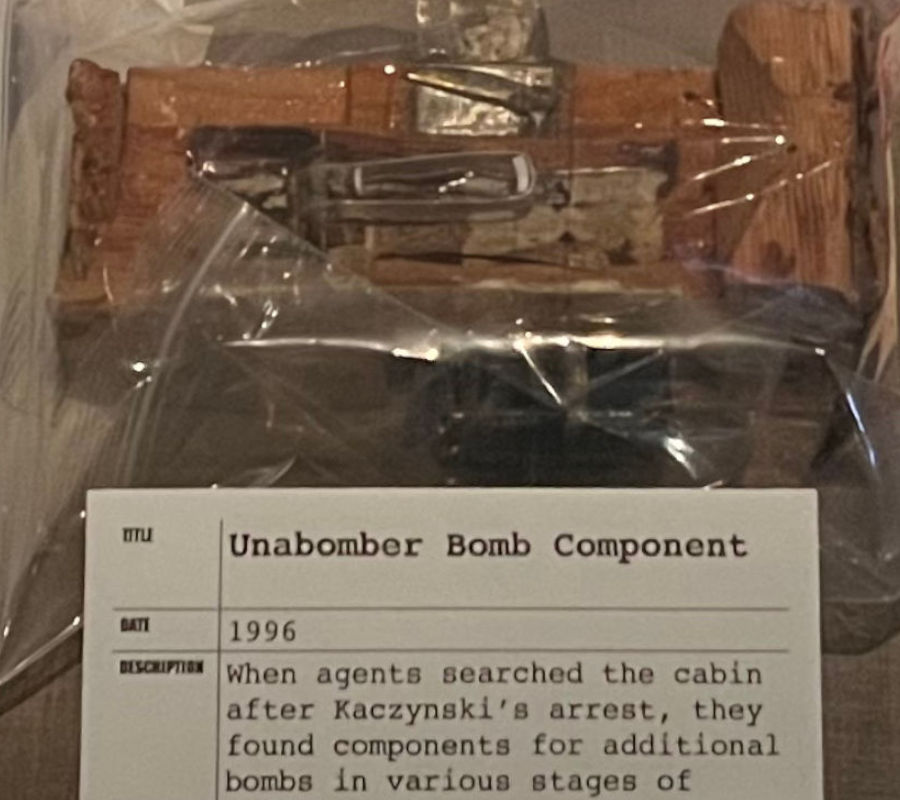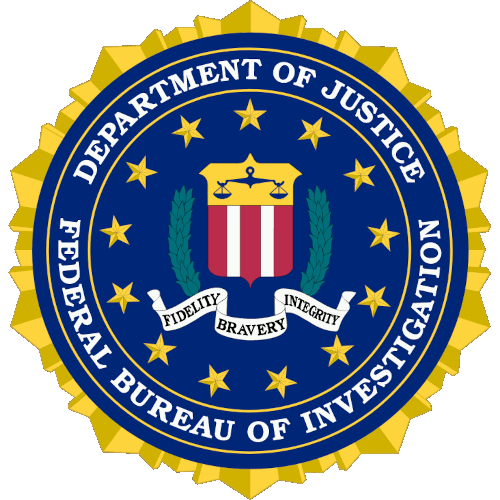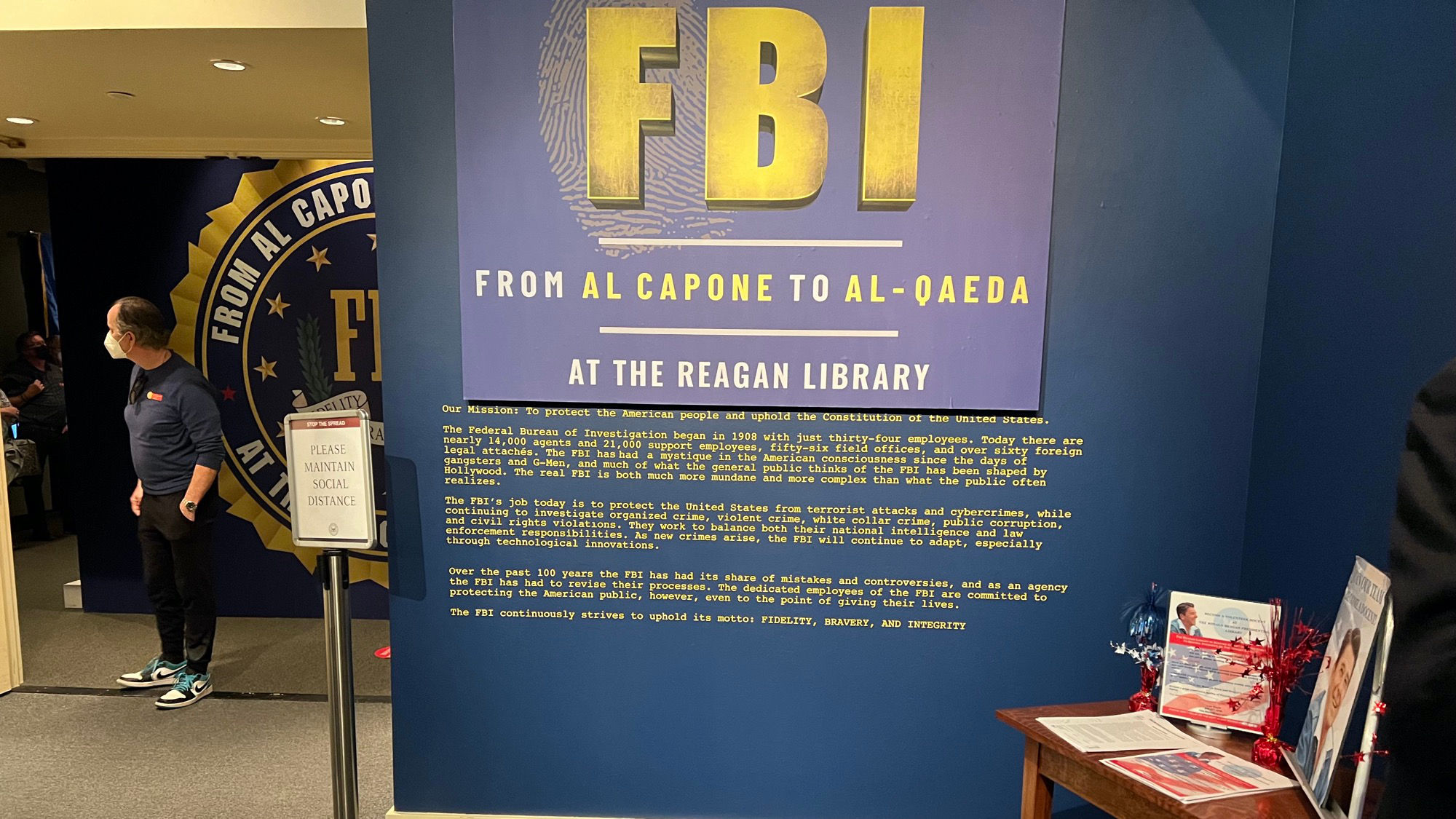
Our Mission: To protect the American people and uphold the Constitution of the United states.
The Federal Bureau of Investigation began in 1908 with just thirty-four employees. Today there are nearly 14,000 agents and 21,000 support employees, fifty-six field offices, and over sixty foreign legal attaches. The FBI has had a mystique in the American consciousness since the days of gangsters and G-Men, and much of what the general public thinks of the FBI has been shaped by Hollywood. The real FBI is both much more mundane and more complex than what the public often realizes.
The FBI's job today is to protect the United States from terrorist attacks and cybercrimes, while continuing to investigate organized crime, violent crime, white collar crime, public corruption, and civil rights violations. They work to balance both their national intelligence and law enforcement responsibilities. As new crimes arise, the FBI will continue to adapt, especially through technological innovations.
Over the past 100 years the FBI has had its share of mistakes and controversies, and as an agency the FBI has had to revise their processes. The dedicated employees of the FBI are committed to protecting the American public, however, even to the point of giving their lives.
The FBI continuously strives to uphold its motto:
FIDELITY, BRAVERY, AND INTEGRITY
G-Man: - means an FBI agent. It stands for Government Man.Machine Gun Kelly said it first while surrendering in 1933 shouting "Don't shoot, G-Men!"
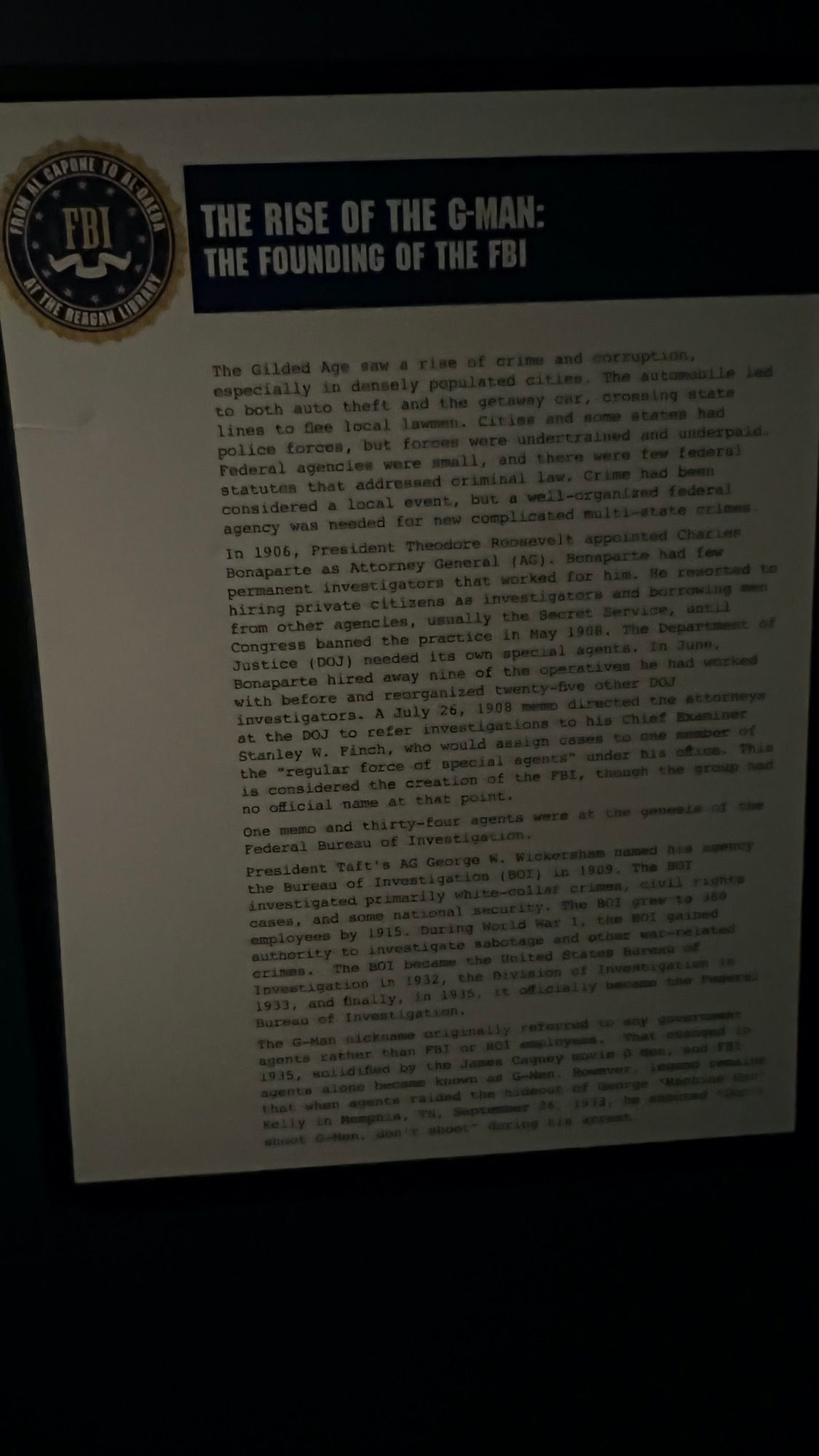
The Founding of the FBI
The Gilded Age saw a rise of crime and corruption, especially in densely papulated cities. The automobile led to both auto theft and the getaway car, cronning atate lines to flee local lawmen. Cities and some states had police forces, but forces wore undertrained and underpald. Federal agencies were small, and there were few federal statutes that addressed criminal law. Crime had been considered a local event, but a well-organized federal agency was needed for new complicated multi-state crimes.
In 1906, President Theodore Roosevelt appointed Charles Bonaparte as Attorney General (AG). Bonaparte had few permanent investigators that worked for him. He resorted to hiring private citizens as investigators and borrowing from other agencies, usually the Secret Service, until Congress banned the practice In May 1908. The Department Justice (DOJ) needed its own special agents. In June, Bonaparte hired away nine of the operatives he had worker with before and reorganized twenty-five ather DOJ investigators. A July 26, 1908 memo directed the attorneys at the DOJ to refer investigations to his Chief Examiner Stanley W. Finch, who would asaign cases to one menber the "regular force of special agents" under his office. This is considered the creation of the PBI, though the group had no official name at that point.
One memo and thirty-four agents were at the genesis of Federal Bureau of Investigation.
President Taft's AG George W. Wickersham named his agency the Bureau of Investigation (BOI) in 1909. The BOI investigated primarily white-collar crimes, clvil right cases, and some national security. The BOI grew to 160 employees by 1915. During World War I, the BOI gained authority to investigate sabotage and othar war-relate crimes. The BO1 became the United States Bureau of Investigation in 1932, the Division of Investigation in 1933, and finally, in 1935, it officially became the Federal Bureau of Investigation. The G-Man nickname originally referred to any government agents rather than FBI ar BOI employees. That changed in 1935, solidified by the Janes Cagney movie G Men, and FBI agents alone became known a G-Men. However, legend remains that when agents ralded the hide out of "Machine Gun Kelly" in Memphis, TN, September 26, 1913, he shouted "Don't shoot G-Men, don't shoot" during his arrest.
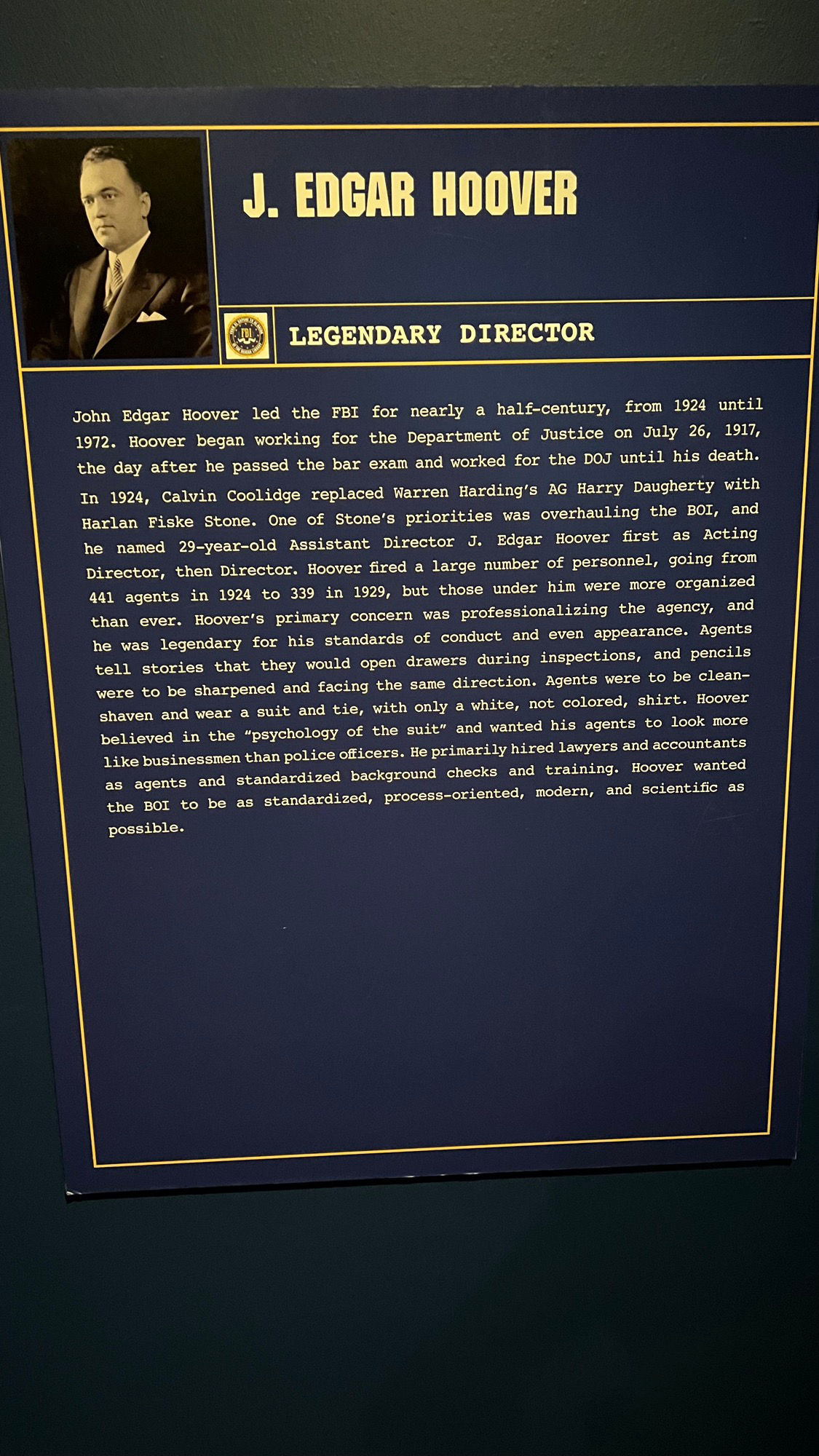
Legendary Director
John Edgar Hoover led the FBI for nearly a half-century, from 1924 until 1972. Hoover began working for the Department of Justice on July 26, 1917, the day after he passed the bar exam and worked for the DOJ until his death.
In 1924, Calvin Coolidge replaced Warren Harding's AG Harry Daugherty with Harlan Fiske Stone. One of Stone's priorities was overhauling the BOI, and he named 29-year-old Assistant Director J. Edgar Hoover first as Acting Director, then Director. Hoover fired a large number of personnel, going from 441 agents in 1924 to 339 in 1929, but those under him were more organized than ever. Hoover's primary concern was professionalizing the agency, and he was legendary for his standards of conduct and even appearance. Agents tell stories that they would open drawers during inspections, and pencils were to be sharpened and facing the same direction. Agents were to be clean-shaven and wear a suit and tie, with only a white, not colored, shirt. Hoover believed in the "psychology of the suit" and wanted his agents to look more like businessmen than police officers. He primarily hired lawyers and accountants as agents and standardized background checks and training. Hoover wanted the BOI to be as standardized, process-oriented, modern, and scientific as possible.
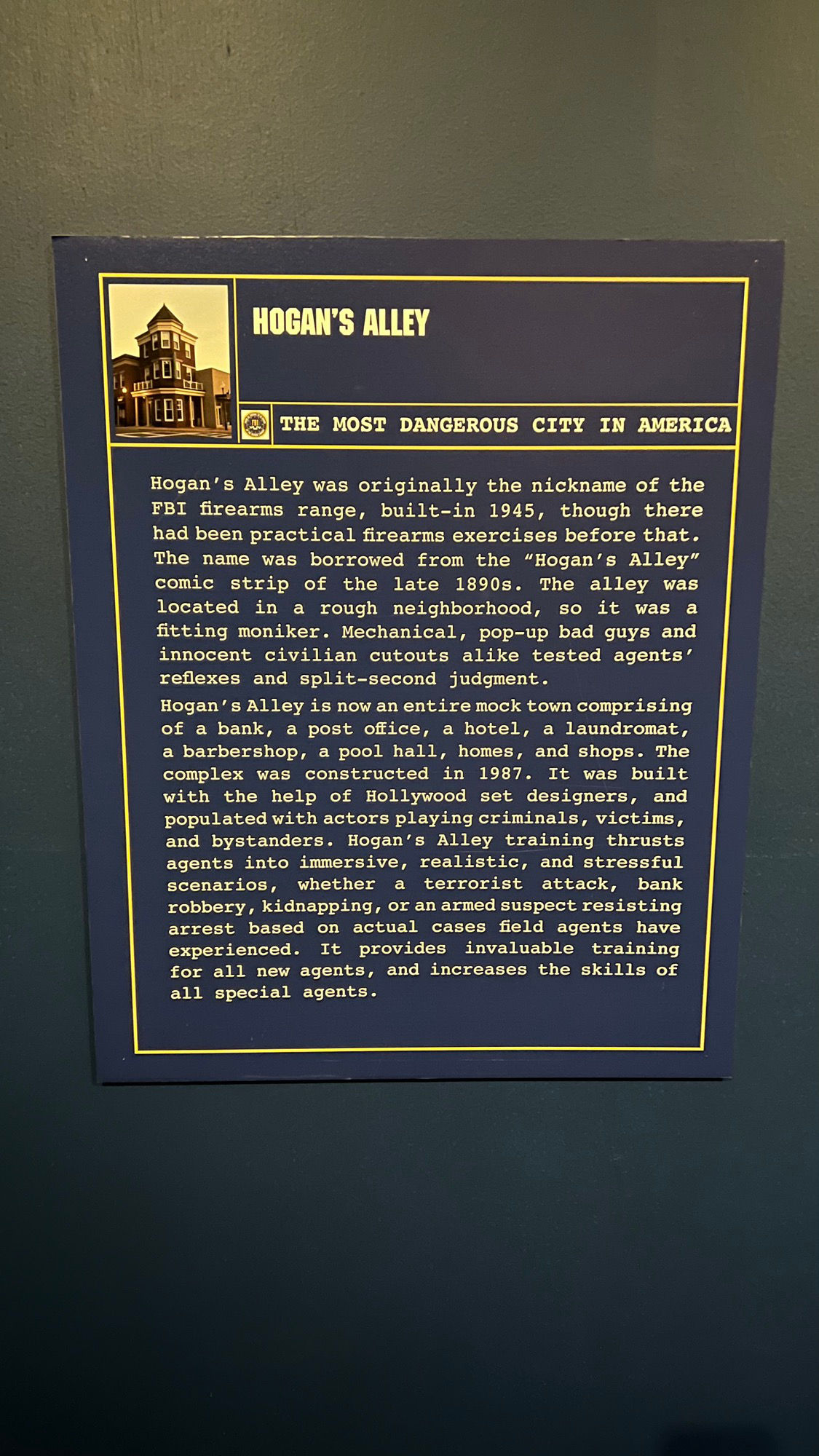
The Most Dangerous City in America
Hogan's Alley was originally the nickname of the FBI firearms range, built-in 1945, though there had been practical firearms exercises before that. The name was borrowed from the "Hogan's Alley" comic strip of the late 1890s. The alley was located in a rough neighborhood, so it was a fitting moniker. Mechanical, pop-up bad guys and innocent civilian cutouts alike tested agents' reflexes and split-second judgment.
Hogan's Alley is now an entire mock town comprising of a bank, a post office, a hotel, a laundromat, a barbershop, a pool hall, homes, and shops. The complex was constructed in 1987. It was built with the help of Hollywood set designers, and populated with actors playing criminals, victims, and bystanders. Hogan's Alley training thrusts agents into immersive, realistic, and stressful scenarios, whether a terrorist attack, bank robbery, kidnapping, or an armed suspect resisting arrest based on actual cases field agents have experienced. It provides invaluable training for all new agents, and increases the skills of all special agents.
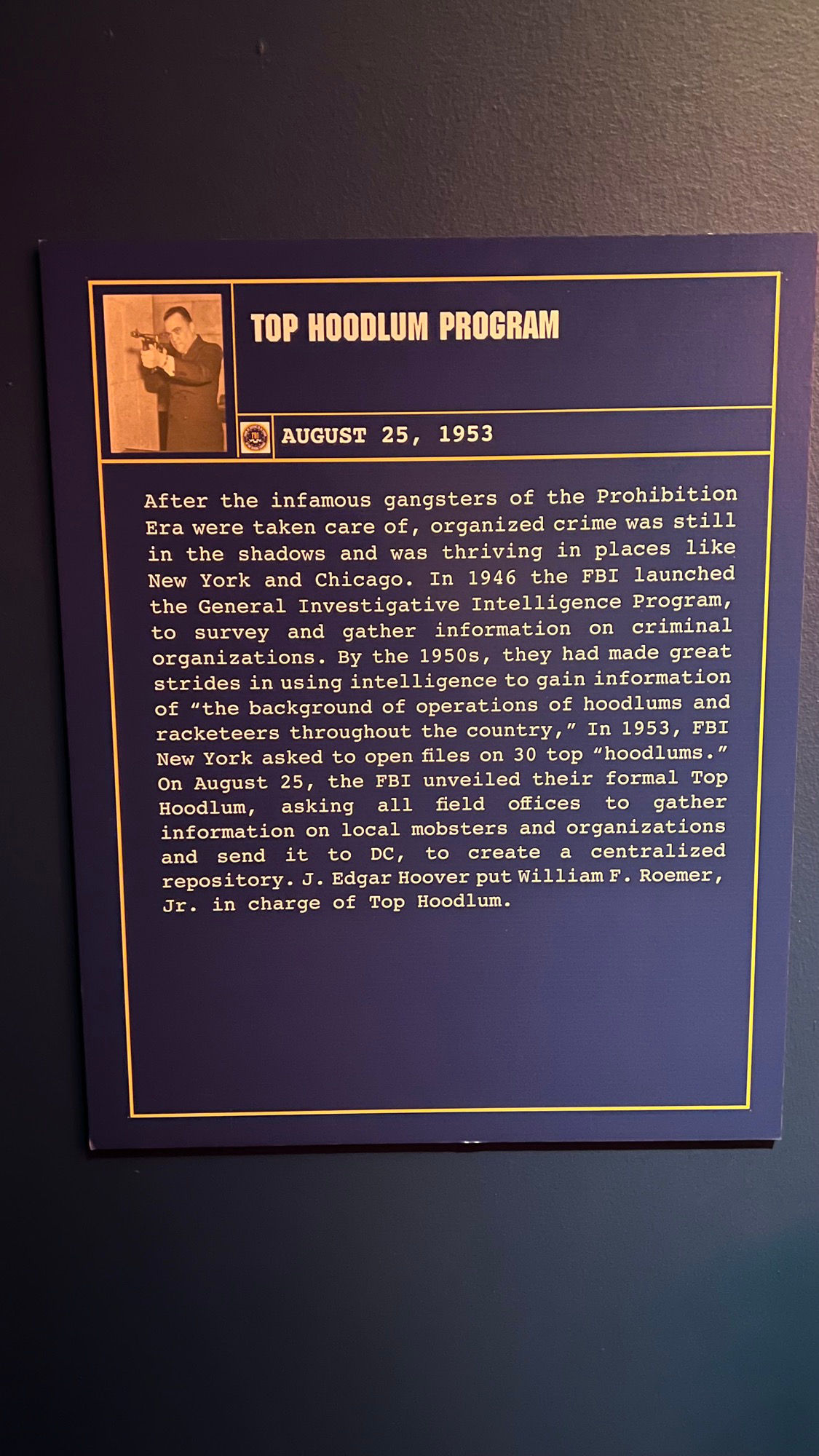
August 25, 1953
After the infamous gangsters of the Prohibition Era were taken care of, organized crime was still in the shadows and was thriving in places like New York and Chicago. In 1946 the FBI launched the General Investigative Intelligence Program, to survey and gather information on criminal organizations. By the 1950s, they had made great strides in using intelligence to gain information of "the background of operations of hoodlums and racketeers throughout the country." In 1953, FBI New York asked to open files on 30 top "hoodlums." On August 25, the FBI unveiled their formal Top Hoodlum, asking all field offices to gather information on local mobsters and organizations and send it to DC, to create a centralized repository. J. Edgar Hoover put William F. Romer, Jr. in charge of Top Hoodlum.
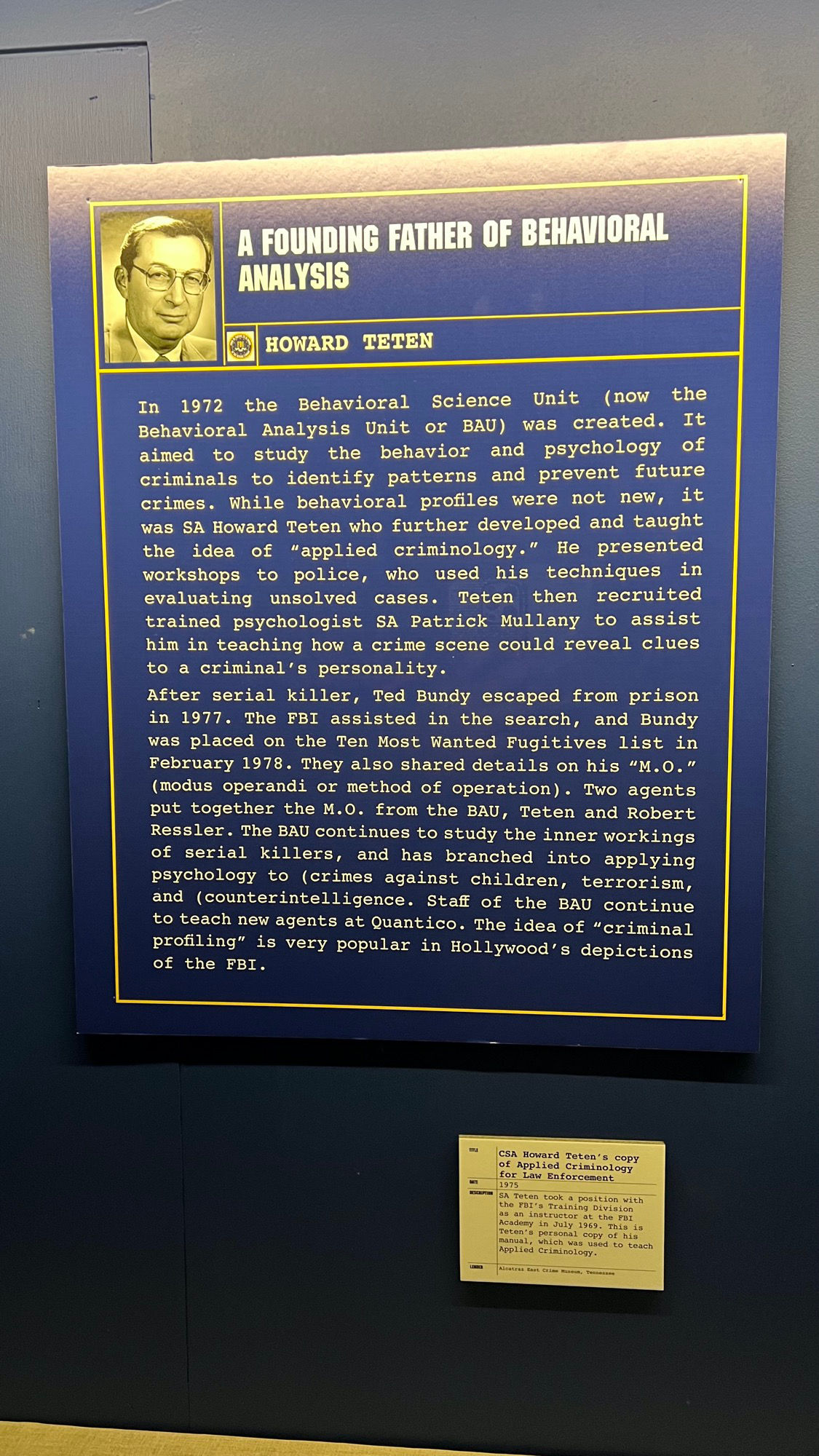
Howard Teten
In 1972 the Behavioral Science Unit (now the Behavioral Analysis Unit or BAU) was created. It aimed to study the behavior and psychology of criminals to identify patterns and prevent future crimes. While behavioral profiles were not new, it was Special Agent Howard Teten who further developed and taught the idea of "applied criminology." He presented workshops to police, who used his techniques in evaluating unsolved cases. Teten then recruited trained psychologist Special Agent Patrick Mullany to assist him in teaching how a crime scene could reveal clues to a criminal's personality.
After serial killer, Ted Bundy escaped from prison in 1977. The FBI assisted in the search, and Bundy was placed on the Ten Most Wanted Fugitives list in February 1978. They also shared details on his "M.O." (modus operandi or method of operation). Two agents put together the M.O. from the BAU, Teten and Robert Ressler. The BAU continues to study the inner workings of serial killers, and has branched into applying psychology to crimes against children, terrorism, and counterintelligence. Staff of the BAU continue to teach new agents at Quantico. The idea of "criminal profiling" is very popular in Hollywood's depictions of the FBI.
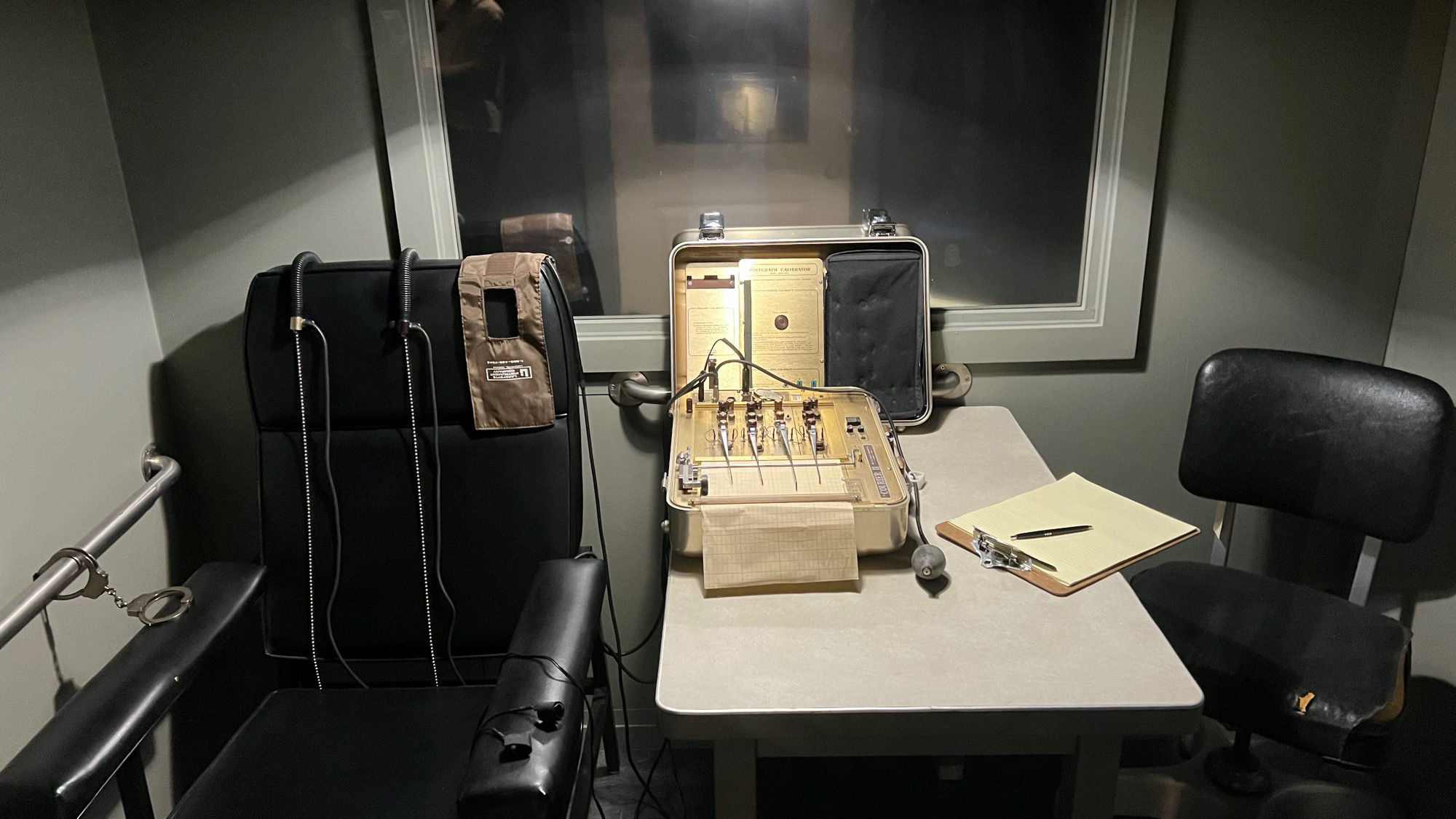
Polygraph Examination Room
A polygraph, or "lie detector test," is one of the tools the FBI can use in interrogating suspects. It measures a person's physical and biological responses, such as heart rate and blood pressure, to the questions asked by the examiner, and usually takes two to four hours to complete. The FBI also uses the polygraph as part of its hiring process. All new agent hires are polygraphed on two issues: prior drug usage and counterintelligence/national security risks.
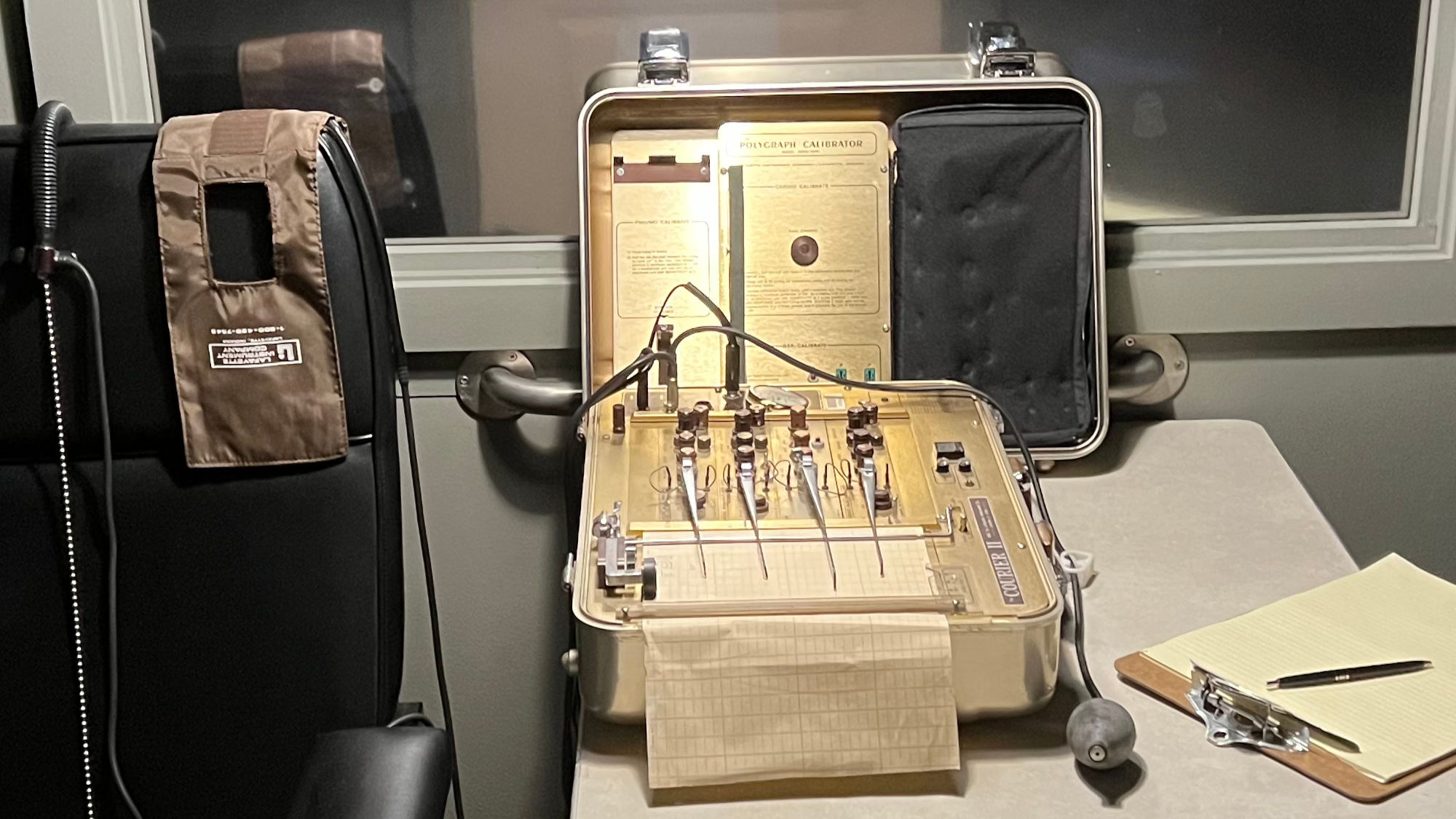
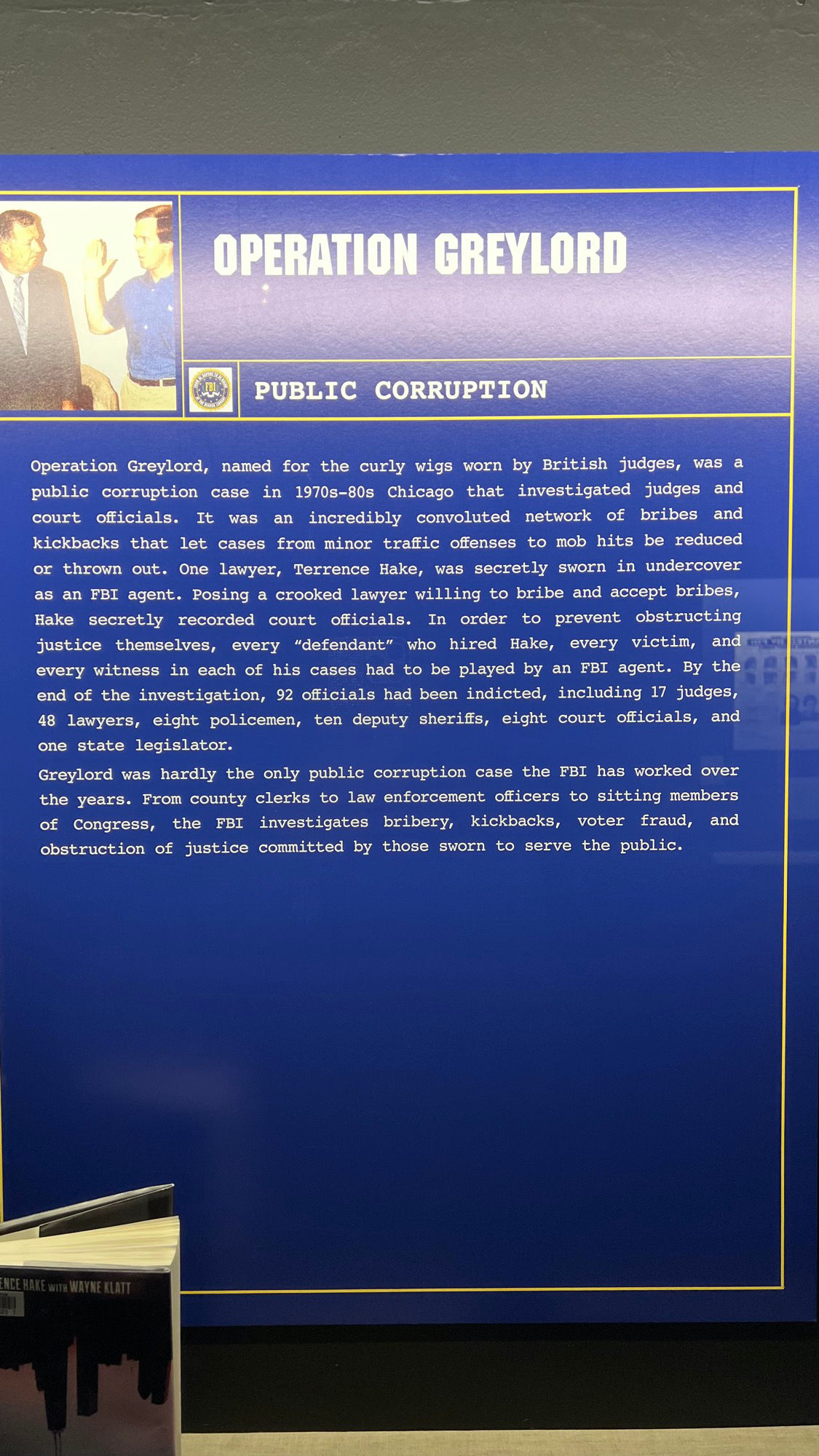
Public Corruption
Operation Greylord, named for the curly wigs worn by British judges, was a public corruption case in 1970-80s Chicago that investigated judges and court officials. It was an incredibly convoluted network of bribes and kickbacks that let cases from minor traffic offenses to mob hits be reduced or thrown out. One lawyer, Terrence Hake, was secretly sworn in undercover as an FBI agent. Posing as a crooked lawyer willing to bribe and accept bribes, Hake secretly recorded court officials. In order to prevent obstructing justice themselves, every "defendant" who hired Hake, every victim, and every witness in each of his cases had to be played by an FBI agent. By the end of the investigation, 92 officials had been indicted, including 17 judges, 48 lawyers, eight policemen, ten deputy sheriffs, eight court officials, and one state legislator.
Greylord was hardly the only public corruption case the FBI has worked over the years. From county clerks to law enforcement officers to sitting members of Congress, the FBI investigates bribery, kickbacks, voter fraud, and obstruction of justice committed by those sworn to serve the public.
FBIOperation Greylord
It was one of the most important cases in the annals of public corruption investigations in the United States.On March 15, 1984, in a federal courtroom in Chicago, a jury found Harold Conn guilty on all four counts of accepting bribes to be passed on to Cook County, Illinois judges as payment for fixing tickets. The evidence? He had been caught live on FBI tapes.
This "bagman" had been the deputy traffic court clerk in the Cook County judicial system, and he was the first defendant to be found guilty in a mammoth sting investigation of crooked officials in the Cook County courts.
It was called Operation Greylord, named after the curly wigs worn by British judges.
And in the end-through undercover operations that used honest and very courageous judges and lawyers posing as crooked ones and with the strong assistance of the Cook County court and local police-92 officials were indicted, including 17 judges, 48 lawyers, eight policemen, 10 deputy sheriffs, eight court officials, and one state legislator. Nearly all were convicted, most of them pleading guilty. It was an important first step to cleaning up the administration of justice in Cook County.
That's really the whole point. Abuse of the public trust cannot and must not be tolerated. Corrupt practices in government strike at the heart of social order and justice. And that's why the FBI has the ticket on investigations of public corruption as a top priority.
Historically, of course, these cases were considered local matters. A county court clerk taking bribes? Let the county handle it.
But in the 1970s, state and local officials asked for help. They didn't have the resources to handle such intense cases, and they valued the authority and credibility that outside investigators brought to the table. By 1976, the Department of Justice had created a Public Integrity Section, and the FBI was tasked with the investigations, focusing on major, systemic corruption in the body politic.
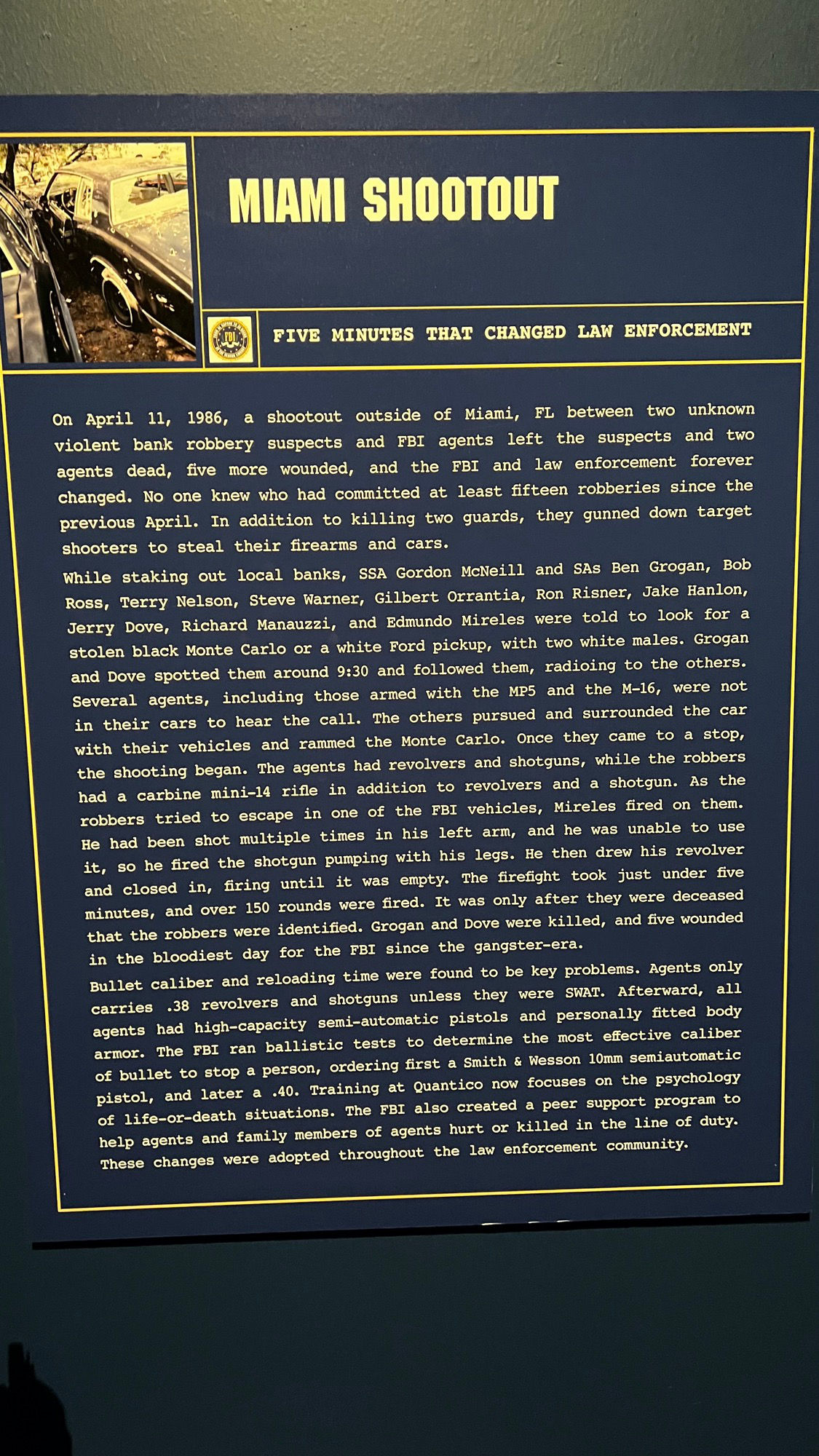
Five Minutes that Changed Law Enforcement
On April 11, 1986, a shootout outside of Miami, FL between two unknown violent bank robbery suspects and FBI agents left the suspects and two agents dead, five more wounded, and the FBI and law enforcement forever changed. No one knew who had committed at least fifteen robberies since the previous April. In addition to killing two guards, they gunned down target shooters to steal their firearms and cars.
While staking out local banks, SSpecial Agent Gordon McNeill and Special Agents Ben Grogan, Bob Ross, Terry Nelson, Steve Warner, Gilbert Orrantia, Ron Risner, Jake Hanlon, Jerry Dove, Richard Manauzzi, and Edmundo Mireles were told to look for a stolen black Monte Carlo or a white Ford pickup, with two white males. Grogan and Dove spotted them around 9:30 and followed them, radioing to the others. Several agents, including those armed with the MP5 and the M-16, were not in their cars to hear the call. The others pursued and surrounded the car with their vehicles and rammed the Monte Carlo. Once they came to a stop, the shooting began. The agents had revolvers and shotguns, while the robbers had a carbine mini-14 rifle in addition to revolvers and a shotgun. As the robbers tried to escape in one of the FBI vehicles, Mireles fired on them. He had been shot multiple times in his left arm, and he was unable to use it, so he fired the shotgun pumping with his legs. He then drew his revolver and closed in, firing until it was empty. The firefight took just under live minutes, and over 150 rounds were fired. It was only after they were deceased that the robbers were identified. Grogan and Dove were killed, and five wounded in the bloodiest day for the FBI since the gangster-era.
Bullet caliber and reloading time were found to be key problems. Agents only carries .38 revolvers and shotguns unless they were SWAT. Afterward, all agents had high-capacity semi-automatic pistols and personally fitted body armor. The FBI ran ballistic tests to determine the most effective caliber of bullet to stop a person, ordering first a Smith & Wesson 10mm semiautomatic pistol, and later a .40. Training at Quantico now focuses on the psychology of life-or-death situations. The FBI also created a peer support program to help agents and family members of agents hurt or killed in the line of duty. These changes were adopted throughout the law enforcement community.
FBIA Byte Out of History
On the morning of April 11, 1986-25 years ago today-one of the deadliest and most violent shoot-outs in FBI history unfolded just outside of the city of Miami.FBI agents were leading a massive manhunt for two violent bank robbers-later identified as Michael Lee Platt and William Russell Matix - who were known for using high-caliber firearms and stolen cars. They had murdered several people since the previous October, and Miami police and the FBI were closing in on them.
Miami Special Agents Benjamin Grogan and Jerry Dove - two of the eight agents ultimately directly involved in the firefight (see sidebar below) who were riding together in one of the five pursuing Bureau cars - noticed a stolen, black Monte Carlo connected to the two robbers and began following it.
Also in close pursuit and riding alone, Special Agent Richard Manauzzi tried to steer the Monte Carlo into a tree at the side of 12201 SW 82nd Avenue when he noticed one of the criminals aiming a weapon toward pursuing FBI agents. Three Bureau cars collided with the suspects and forced them off the road, but the felons opened fire.
The events unfolded quickly and horrifically. Special Agent Manauzzi was seriously wounded and immediately sought cover. Special Agent Gordon McNeill - also riding alone - was wounded, but returned fire, striking Matix. Special Agents Gilbert Orrantia and Ronald Risner were pinned in their vehicle on the other side of the street; Orrantia was wounded. Special Agents Edmundo Mireles and John Hanlon had also stopped their car on the opposite side of the street and came under high-powered rifle fire as they tried to approach the felons. Both were seriously wounded. Special Agents Dove and Grogan - despite wounding both criminals in the hail of bullets - were trapped in their car and killed when Platt fired at close range. Platt also shot and incapacitated Agent Hanlon.
Agents Killed or Harmed on April 11, 1986
- Benjamin P. Grogan, 53, a 25-year veteran; deceased
- Jerry Dove, 30, an agent since 1982; deceased
- Gordon G. McNeill, 43, a 19-year veteran; seriously wounded
- Edmundo Mireles, Jr., 33, an agent since 1979; seriously wounded
- John F. Hanlon, Jr., 48, entered on duty in August 1963; seriously wounded
- Richard A. Manauzzi, 43, 15 years of service; injured, treated, and released
- Gilbert M. Orrantia, 27, on duty since April 1982; injured, treated, and released
Severely wounded and struggling to remain conscious, Special Agent Mireles stood up and began firing at the criminals as they entered and tried to escape in Dove and Grogan's car. He killed both men even as they returned fire.
In the end, the FBI's casualties were higher than any shoot-out in its history: two dead, three seriously wounded, and two others injured. Only Agent Risner was unhurt.
In the aftermath of the gun battle, the FBI and other law enforcement agencies closely studied the incident. Although wounded, both Platt and Matix were able to continue firing their weapons at the surrounding agents. Our guns had not stopped them. Furthermore, the killers' weapons were more powerful and their rounds could penetrate even the armored vests that some of the agents were wearing.
In response to this tragedy, the FBI made significant changes in the firepower carried by agents, the body armor they wore, and the incident response training they received.
Today, we honor not just Agents Dove and Grogan - and their colleagues injured that day - but all of the men and women of the FBI who have given their lives in the line of duty and put themselves in harm's way to protect their communities. As Director Mueller said in a ceremony in Miami attended by former FBI Director William Webster, survivors of the shooting, and many others:
Director MuellerIt has been said that all great things are simple, and most can be expressed in a single word: fidelity, bravery, and integrity. Honor, duty, and sacrifice. But it is no simple matter to act on such words when every second counts and life hangs in the balance. The individuals we honor today embodied the true meaning of these words and what it means to be a special agent.
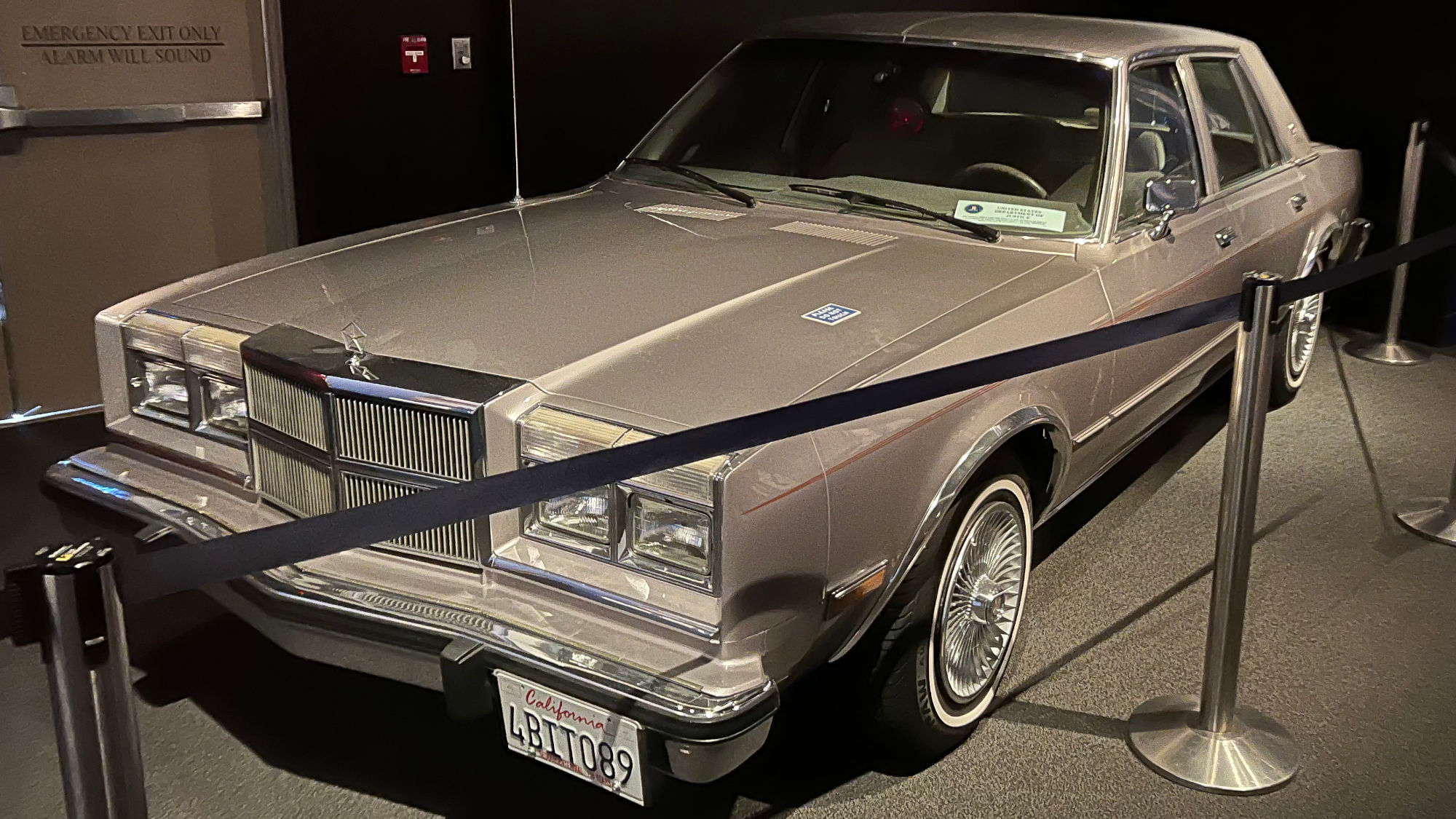
1988 Dodge Diplomat SE
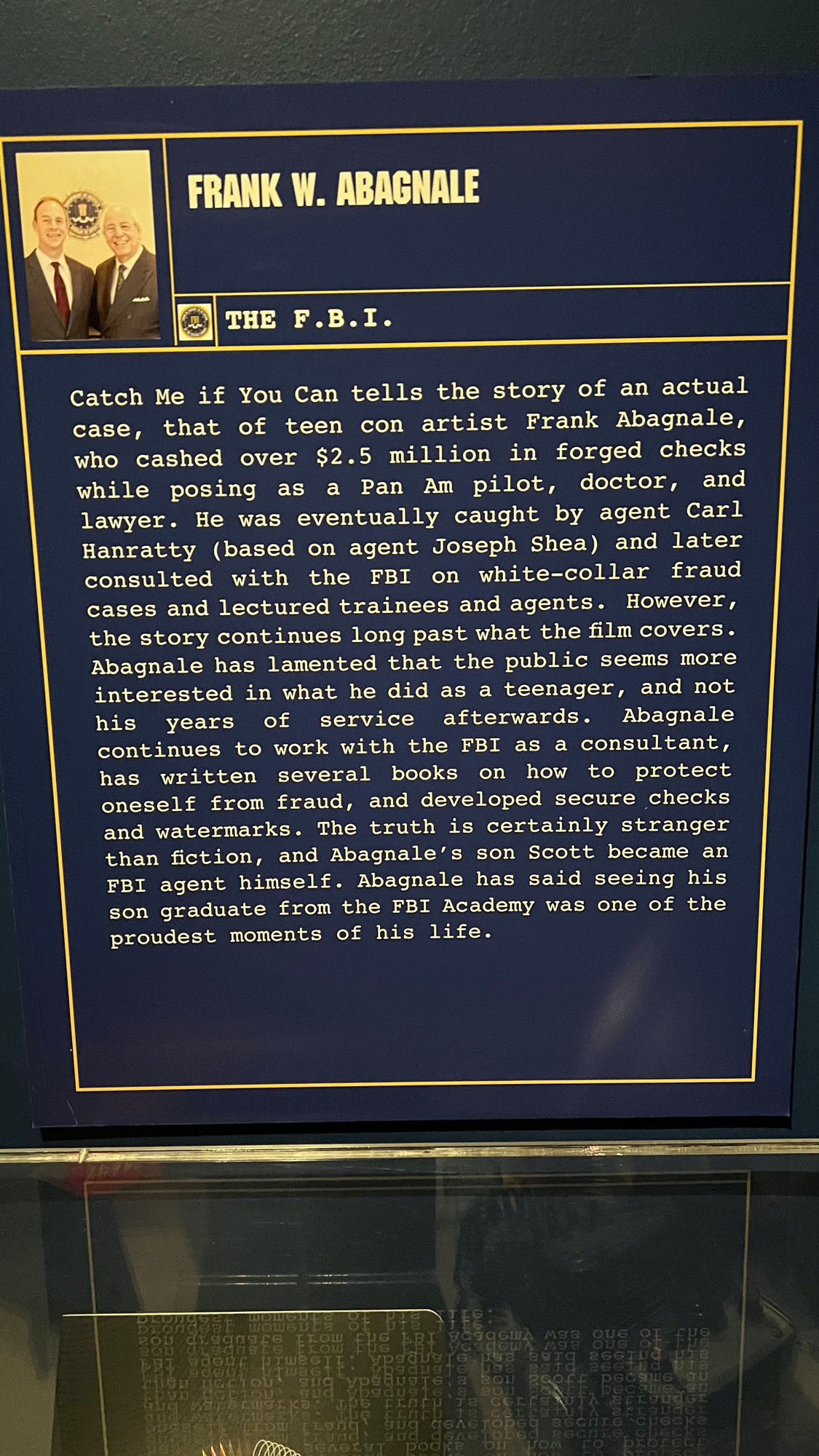
The F.B.I.
Catch Me if You Can tells the story of an actual case, that of teen con artist Frank Abagnale, who cashed over $2.5 million in forged checks while posing as a Pan Am pilot, doctor, and lawyer. He was eventually caught by agent Carl Hanratty (based on agent Joseph Shea) and later consulted with the FBI on white-collar fraud cases and lectured trainees and agents. However, the story continues long past what the film covers.
Abagnale has lamented that the public seems more interested in what he did as a teenager, and not his years of service afterwards. Abagnale continues to work with the FBI as a consultant, has written several books on how to protect oneself from fraud, and developed secure checks and watermarks. The truth is certainly stranger than fiction, and Abagnale's son Scott became an FBI agent himself. Abagnale has said seeing his son graduate from the FBI Academy was one of the proudest moments of his life.
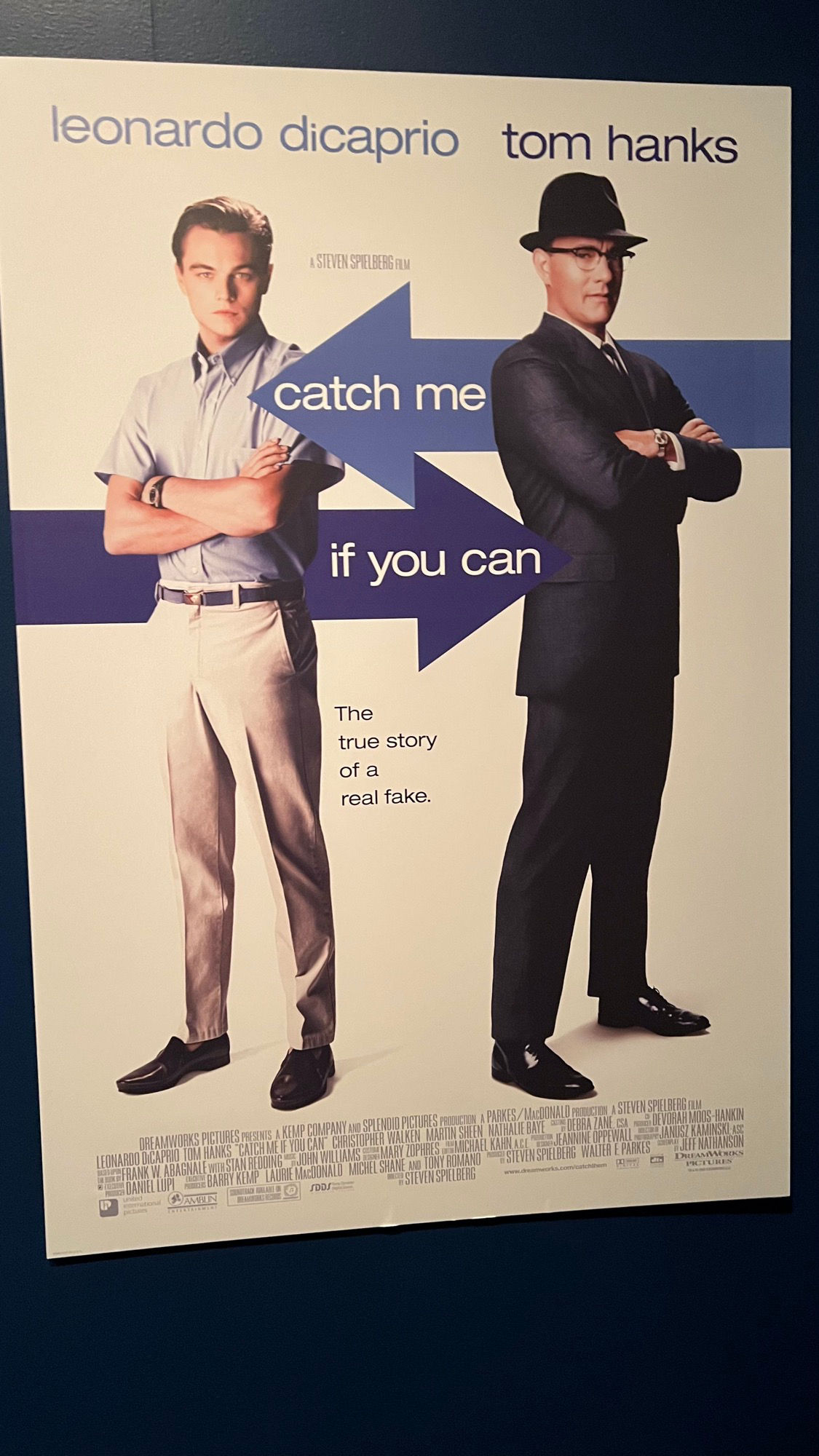
Abagnale's story became both major motion picture in 2002 and a Broadway musical in 2011.
Special Agent Carl Hanratty, played by Tom Hanks in the film Catch Me if You Can, was based on Special Agent Joe Shea.
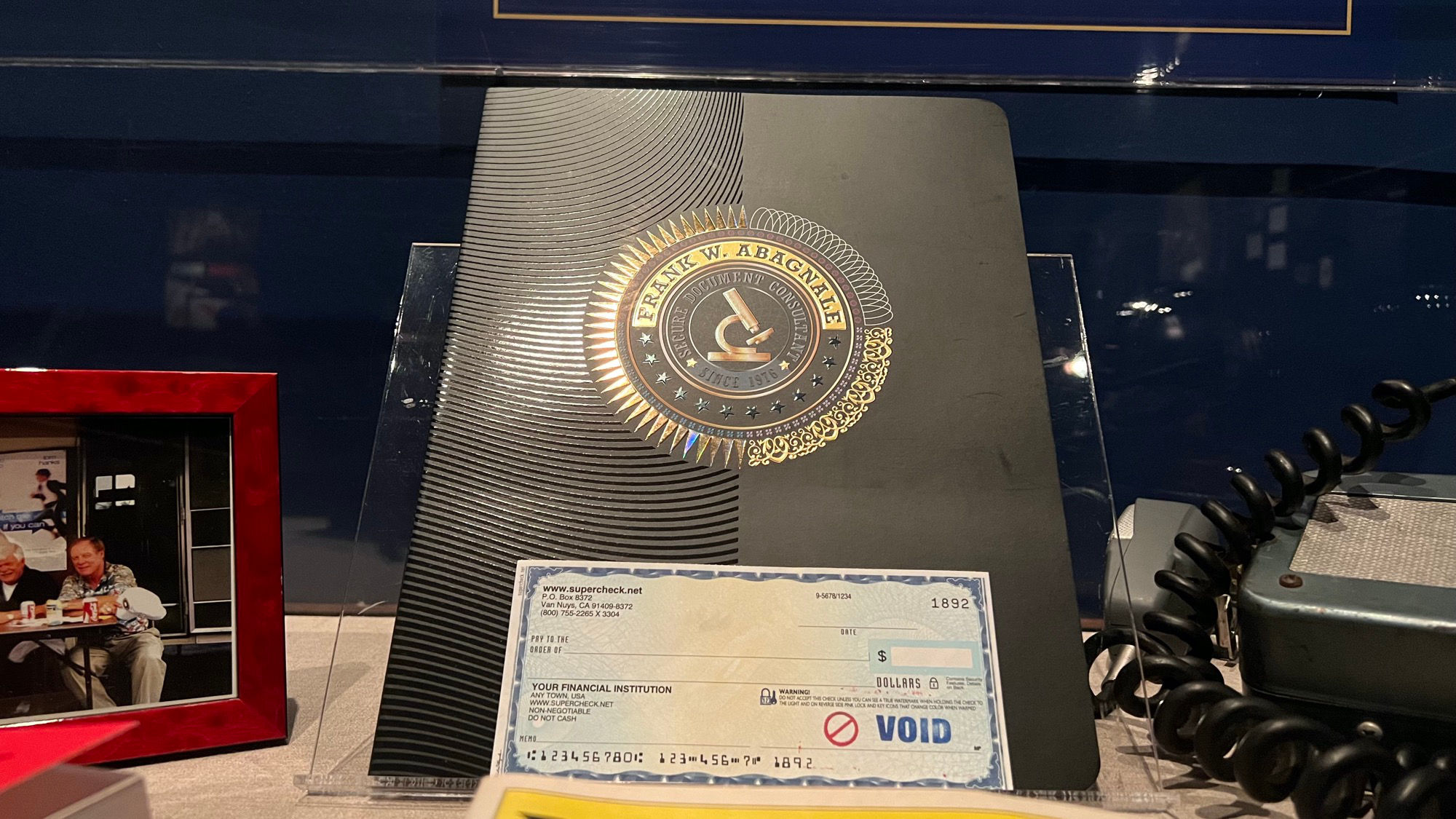
Abagnale is now an expert on forgery, embezzlement, and Secure documents. He continues to lecture at the FBI Academy and FBI field offices.
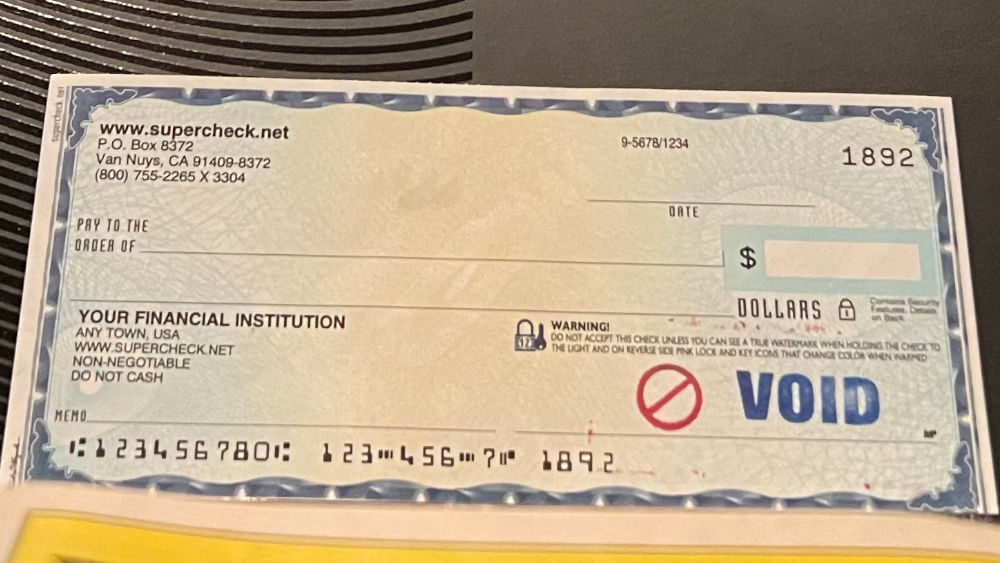
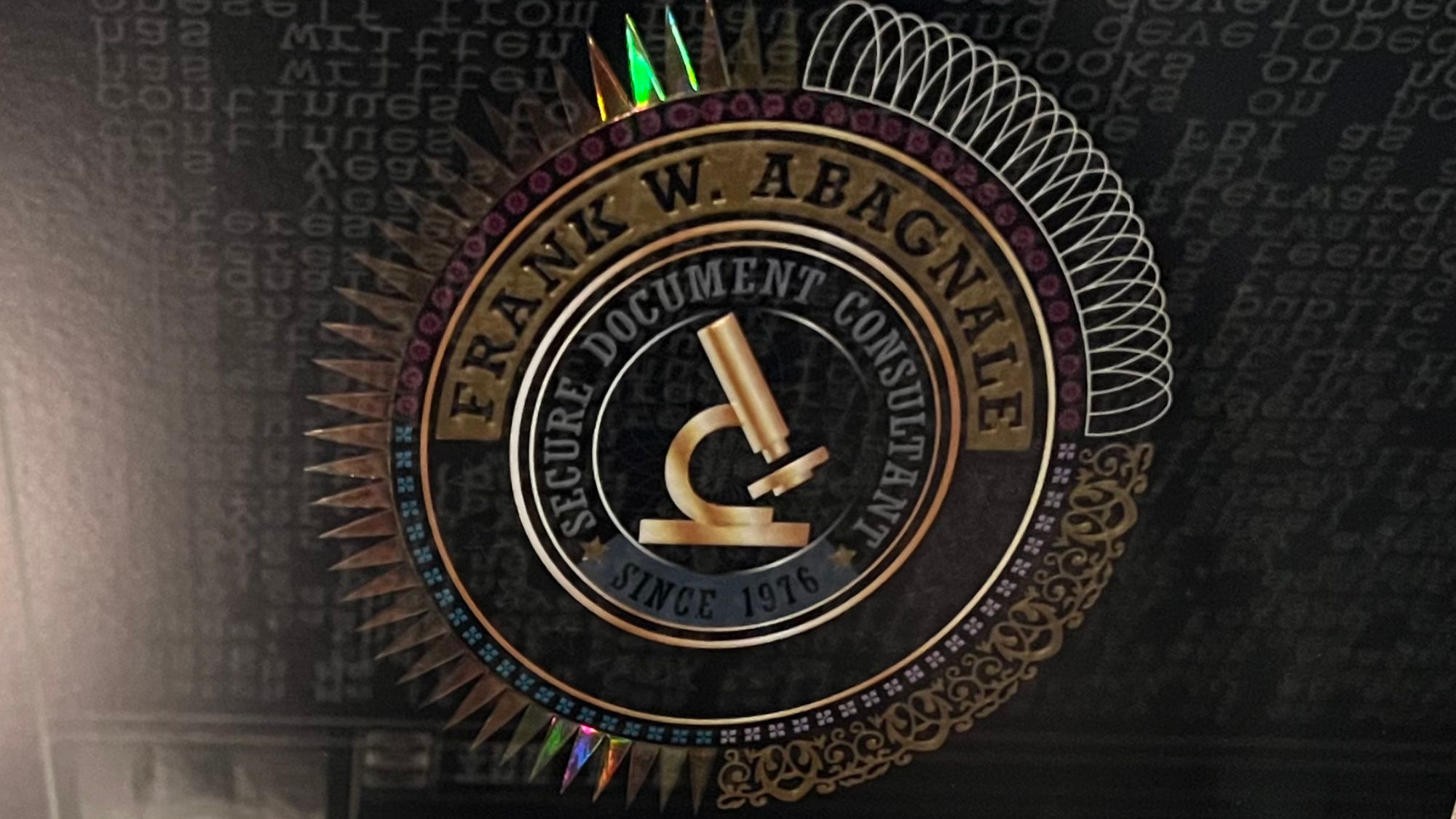
Secure Document Consultant
Since 1976
TV tends to speed up the process when it comes to things like CSI evidence and putting the pieces together. In reality, it can take hundreds or thousands of man-hours to have a case ready to present to the DOJ. Special Agent, New Haven CT
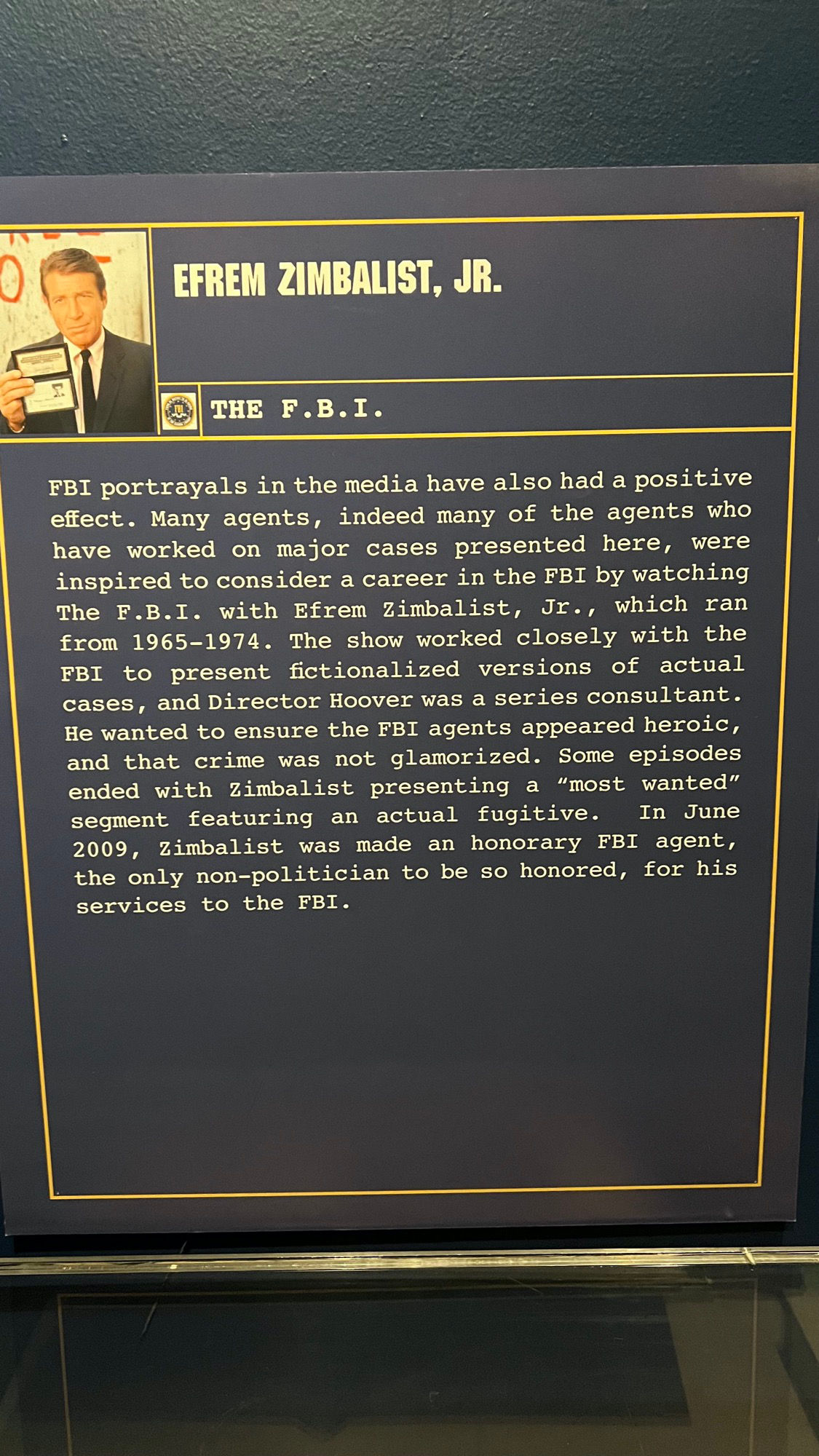
The F.B.I.
FBI portrayals in the media have also had a positive effect. Many agents, indeed many of the agents who have worked on major cases presented here, were inspired to consider a career in the FBI by watching The F.B.I. with Efrem Zimbalist, Jr., which ran from 1965-1974. The show worked closely with the FBI to present fictionalized versions of actual cases, and Director Hoover was a series consultant. He wanted to ensure the FBI agents appeared heroic, and that crime was not glamorized. Some episodes ended with Zimbalist presenting a "most wanted" segment featuring an actual fugitive. In June 2009, Zimbalist was made an honorary FBI agent, the only non-politician to be so honored, for his services to the FBI.
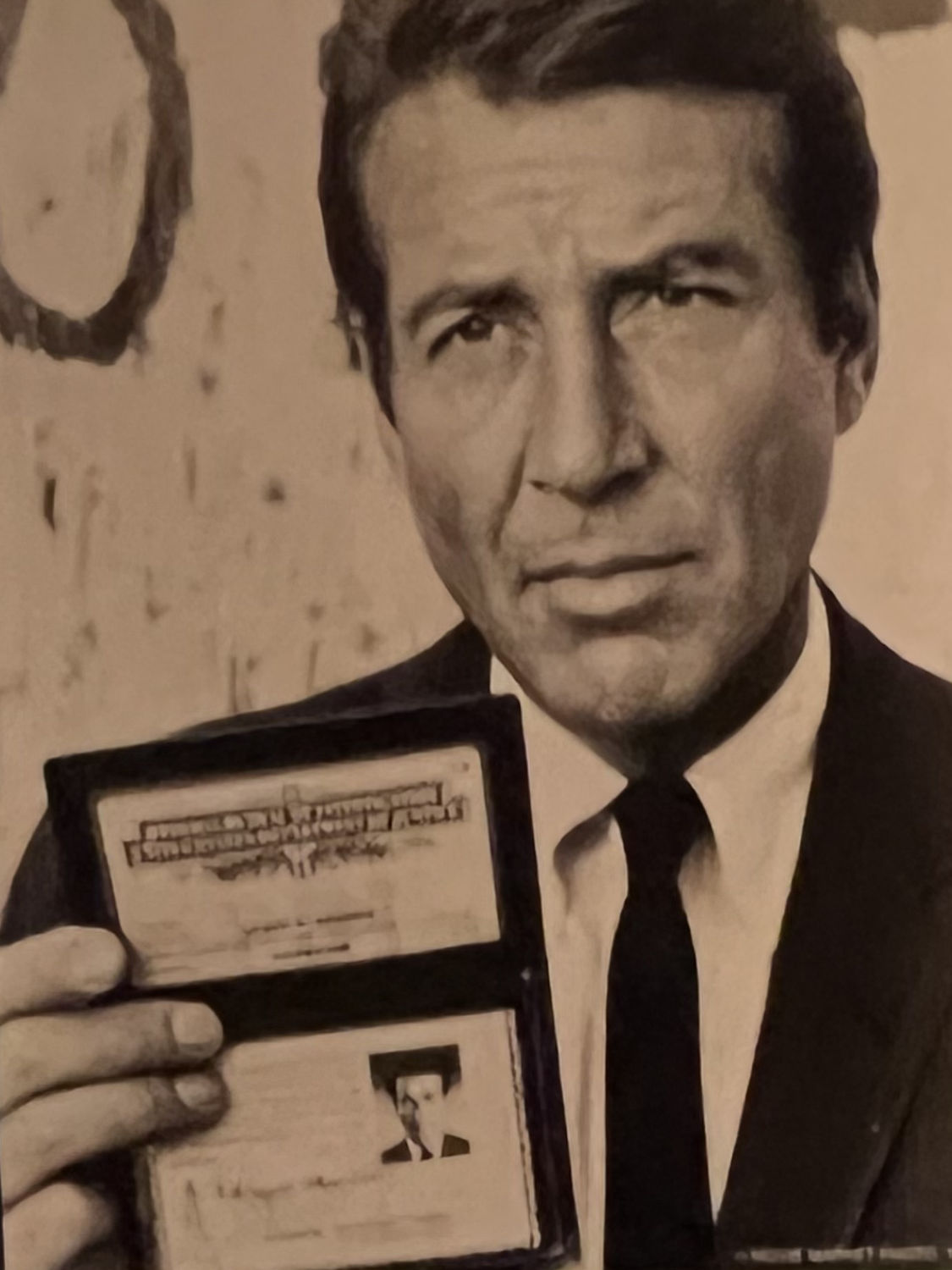
TV Show: "The F.B.I."
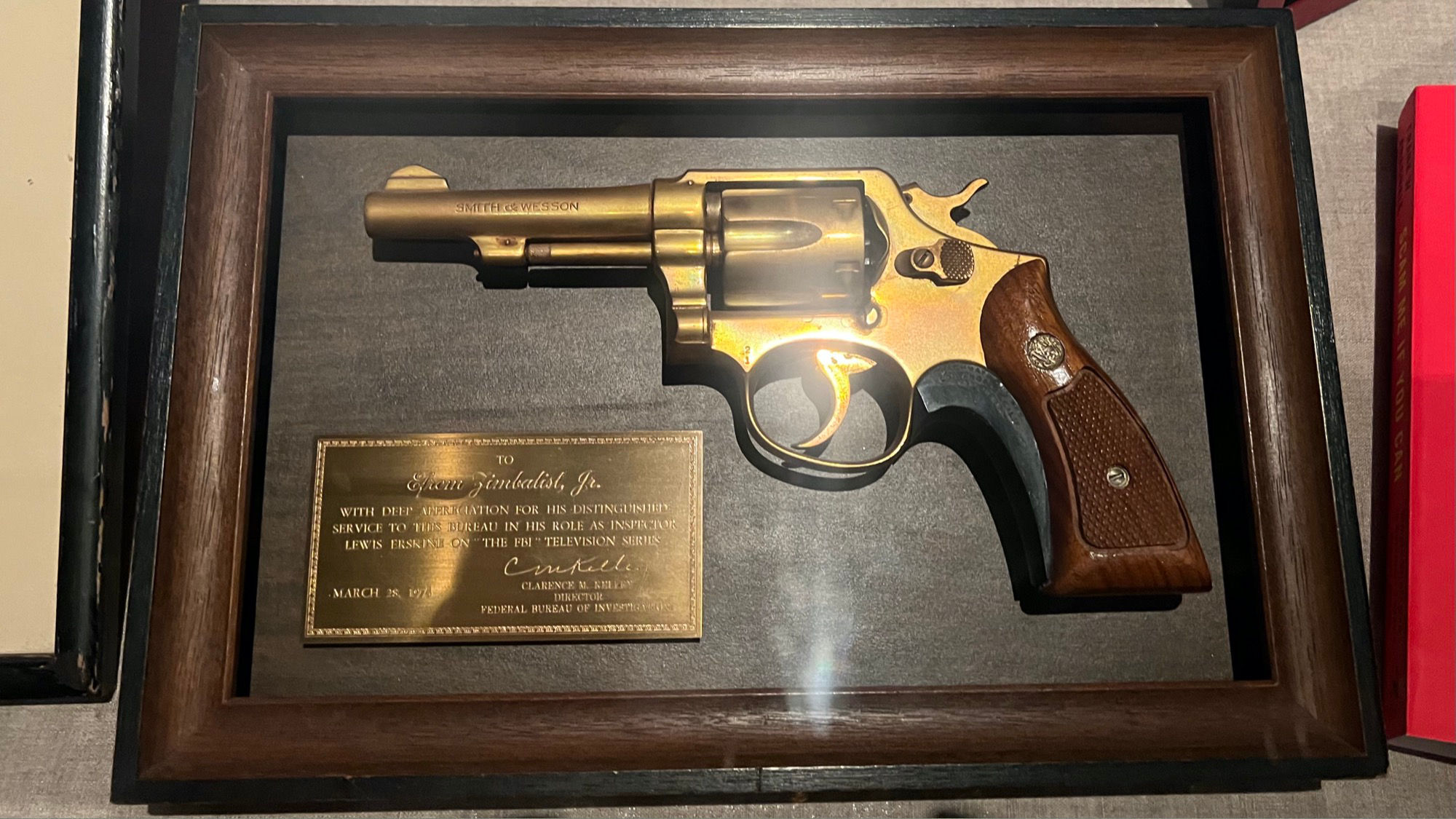
TV Show: "The F.B.I."
Director Clarence M Kelley gave Zimbalist this golden gun for his service to the FBI in his role on the television show.
In 1985, the Society of Former Special Agents of the FBI had also presented Efrem's character, Inspector Lewis Erskine, with a set of retired credentials, but now Zimbalist himself was made an honorary Special Agent.
MARCH 28, 1974To Efrem Zimbalist, Jr.
With deep appreciation for his distinguished service to this bureau in his role as Inspector Lewis Erskine on "The FBI" television seriesClarence M Kelley
Director
Federal Bureau of Investigation
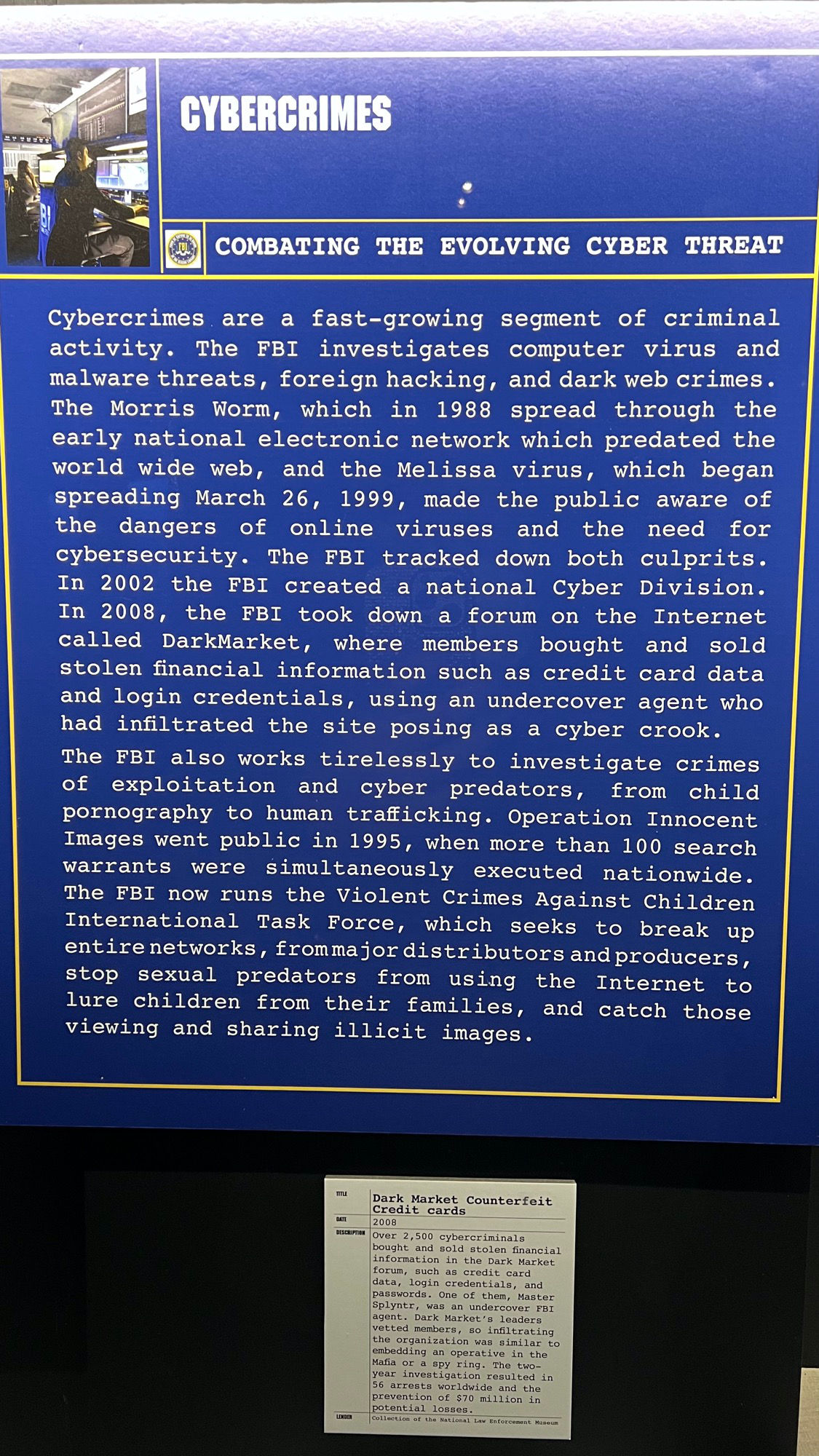
Combating the Evolving Cyber Threat
Cybercrimes are a fast-growing segment of criminal activity. The FBI investigates computer virus and malware threats, foreign hacking, and dark web crimes. The Morris Worm, which in 1988 spread through the early national electronic network which predated the world wide web, and the Melissa virus, which began spreading March 26, 1999, made the public aware of the dangers of online viruses and the need for cybersecurity. The FBI tracked down both culprits.
In 2002 the FBI created a national Cyber Division. In 2008, the FBI took down a forum on the Internet called DarkMarket, where members bought and sold stolen financial information such as credit card data and login credentials, using an undercover agent who had infiltrated the site posing as a cyber crook.
The FBI also works tirelessly to investigate crimes of exploitation and cyber predators, from child pornography to human trafficking. Operation Innocent Images went public in 1995, when more than 100 search warrants were simultaneously executed nationwide. The FBI now runs the Violent Crimes Against Children International Task Force, which seeks to break up entire networks from major distributors and producers, stop sexual predators from using the Internet to lure children from their families, and catch those viewing and sharing illicit images.
CYBERCRIMESDark Market Counterfeit Credit Cards
2008Over 2,500 cybercriminals bought and sold stolen financial information in the Dark Market forum, such as credit card data, login credentials, and passwords. One of them, Master Splyntr, was an undercover FBI agent. Dark Market's leaders vetted members, so infiltrating the organization was similar to embedding an operative in the Mafia or a spy ring. The two-year investigation resulted in 56 arrests worldwide and the prevention of $70 million in potential losses.
